Gardenia

Gardenia, with its radiant white petals and intoxicating fragrance, is a beacon of purity and a treasure in any garden.
Originating from tropical Asia and Africa, its allure carries deep symbolism and enchanting use cases.
Gardenias are frequently chosen to convey trust, love, respect, and clarity between individuals.
Meaning and Symbolism
In various cultures, Gardenias are viewed as more than just flowers; they are messengers.
They often play a vital role in ceremonies, used as offerings to deities—embodying beauty, purity, and self-reflection.
Sun Requirements and Bloom Time
- Sun Requirements: Partial sunlight is perfect for Gardenias to thrive.
- Bloom Time: Their pristine blooms grace gardens from late spring to early summer, creating a mesmerizing display.
Soil and Water Needs
To maintain their luminous white blossoms, Gardenias demand:
- Soil: Well-drained, rich, acidic soil is a must.
- Water: Regular watering keeps them in prime condition, but take care not to overwater.
USDA Growing Zones and Care
USDA Zone: These flowers flourish in zones 8 to 11, basking in the warmth.
Their care involves routine checks for pests and diseases, ensuring these beauties remain blemish-free.
Lily Of The Valley

Meaning and Use Cases:
The enchanting Lily of The Valley bursts with symbolism and is esteemed for its delicate appearance and delightful fragrance.
Garnering associations with luck, happiness, and purity, it often graces weddings and May Day celebrations.
Its tiny, bell-shaped flowers have secured a place in hearts as a symbol of motherhood and humility, tied historically to the Virgin Mary.
Sun Requirements:
Fond of cooler environments, the Lily of the Valley thrives in partial to full shade.
It’s a beacon of light in shadowy garden spots where other flowers might shy away.
Bloom Time:
Come spring, gardens are graced with its presence, typically in the delightful month of May, hence its link to May Day festivities.
Soil Requirements:
They favor well-drained soil, rich in organic matter, reflecting their need for a nurturing environment to mirror their nurturing symbolism.
USDA Zone:
Remarkably hardy, Lily of the Valley plants are suited for a range of climates, falling within USDA zones 2 to 9.
| Feature | Detail |
|---|---|
| Sun Requirements | Partial to full shade |
| Bloom Time | May |
| Soil Requirements | Well-drained, rich in organic matter |
| USDA Zone | 2 to 9 |
Snowdrop

Meaning and Uses: Snowdrops, with their delicate white petals, herald the end of winter and symbolize hope, purity, and new beginnings.
These resilient flowers often appear while snow is still on the ground, signifying the impending arrival of spring.
Because of these traits, they are ideal for celebrations of life and renewal.
Sun Requirements: Snowdrops prefer partial shade, thriving best under deciduous trees that provide sunlight in the winter but shade in the summer.
Bloom Time: These flowers are early bloomers, often poking through the snow in late winter to early spring.
Soil Requirements: They favor moist, well-drained soil with a preference for humus-rich earth.
Snowdrops have a remarkable ability to thrive in cold conditions, embodying strength and resilience.
USDA Zone: Snowdrops are hardy plants suited to zones 3 through 9.
| Aspect | Detail |
|---|---|
| Sun | Partial shade |
| Bloom | Late winter/early spring |
| Soil | Moist, well-drained, humus-rich |
| USDA Zone | 3 – 9 |
White Rose

Meaning and Use Cases:
The white rose, a symbol of purity, innocence, and spirituality, shines in the world of florals.
They are universally recognized as a gesture of remembrance and are a quintessential part of marriages, symbolizing new beginnings.
White roses are not just limited to bouquets and decorations; they have a special place in historical and cultural contexts.
For instance, they represent chastity and are associated with the Virgin Mary in Christianity.
Sun Requirements:
White roses flourish under full sun exposure.
They bask in the glory of the sun’s rays, which significantly contributes to their growth and blooming prowess.
Bloom Time:
Typically, these roses start showing their immaculate petals during late spring and will continue to bloom through fall, gracing gardens with their serene presence for many months.
Soil Requirements:
Well-drained, fertile soil is the foundation for a thriving white rose bush.
They prefer a neutral to slightly acidic pH, ensuring they receive the optimal balance of nutrients.
USDA Zone:
White roses generally thrive in USDA zones 3 through 10, demonstrating their versatility and resilience across varied climates.
- Sunlight: Full sun
- Bloom Time: Late spring to fall
- Soil: Well-drained, fertile, neutral to slightly acidic
- USDA Zones: 3-10
White Tulip

The white tulip stands out in the floral world with its elegant appeal, often regarded as a symbol of purity and innocence.
With its pristine petals, it captures the essence of clarity and grace, making it a beloved choice for occasions that celebrate new beginnings, such as weddings.
Meaning and Use Cases
White tulips are a vibrant emblem of forgiveness and worthiness.
Gardeners and florists treasure these blooms for their ability to convey deep sincerity and respect, making them a poignant selection for sympathy arrangements or gestures of apology.
Sun Requirements
They relish the sunshine and flourish best with at least 6 hours of direct sunlight daily.
This makes them perfect additions to spots in gardens where light lovingly embraces the soil.
Bloom Time
Springtime is when white tulips truly come to life, gracing gardens with their delicate blossoms.
They provide a serene splash of white among the vibrant colors of a spring garden.
Soil Requirements
The white tulip thrives in well-drained soil, which should be kept moist but not waterlogged.
Fertile, neutral to slightly acidic soil is ideal for these elegant flowers.
USDA Zone
Hardy by nature, white tulips generally grow well in USDA zones 3 to 8.
Their adaptability in these zones makes them a joy for gardeners across a variety of climates.
Jasmine
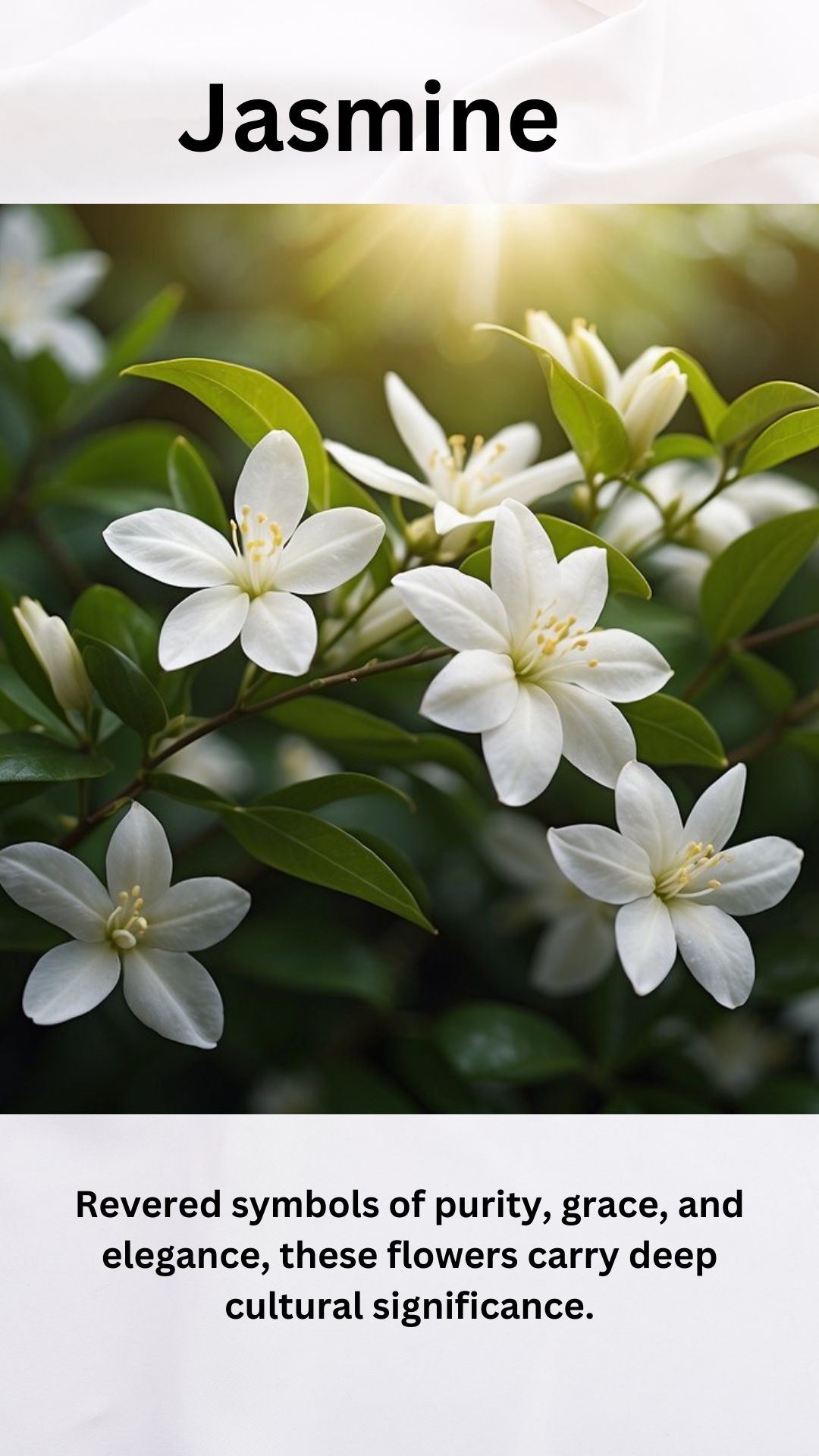
Meaning and Uses
Jasmine is celebrated for its pristine white blossoms and enchanting fragrance.
Revered symbols of purity, grace, and elegance, these flowers carry deep cultural significance.
One can find jasmine flowers gracing wedding ceremonies, symbolizing love and good fortune, and in meditation practices, denoting spirituality.
The soothing scent makes jasmine a popular choice in aromatherapy for promoting a sense of well-being.
Sun Requirements
Jasmine thrives in full to partial sunlight.
Generous exposure to sunlight is key for the flower to bloom abundantly. Yet, they still appreciate a bit of shade during the hottest part of the day in warmer climates.
Bloom Time
These flowers greet the season with their presence mostly in summer, although some varieties may begin their display in spring.
Soil Requirements
Jasmine’s roots desire well-drained, moderately fertile soil.
They are tolerant to a variety but favor a slightly acidic to neutral pH.
USDA Zone
Jasmine plants are suitable for USDA zones 7 through 10.
It’s crucial to choose a variety that fits one’s specific regional climate.
Table: Jasmine At a Glance
| Feature | Detail |
|---|---|
| Meaning | Purity, Love, Good Fortune |
| Sun Requirements | Full to Partial Sun |
| Bloom Time | Summer (some in Spring) |
| Soil Requirements | Well-Drained, Fertile, Acidic to Neutral pH |
| USDA Zone | 7 – 10 |
Daffodil

Daffodils are a herald of spring. Their white varieties symbolize purity, truth, and innocence. Often chosen for their bright appearance and meaningful symbolism, white daffodils grace gardens and bouquets with a touch of elegance.
Meaning and Use Cases:
White daffodils are perfect for occasions that celebrate new beginnings and convey good intentions. Their association with purity makes them a fitting choice for weddings, while their embodiment of truth renders them ideal for heartfelt gestures.
Sun Requirements:
They thrive in full sun to partial shade. White daffodils are versatile enough to cater to different garden layouts and styles.
Bloom Time:
These flowers boast an extended bloom period from mid- to late-spring. They captivate onlookers with their pristine beauty during this time.
Soil Requirements:
White daffodils prefer well-drained soils. This ensures they have the perfect balance of moisture without waterlogging.
USDA Zone:
| USDA Zone | Suitability |
|---|---|
| Zone 3 | Generally hardy |
| Zone 4-8 | Ideal conditions |
| Zone 9 | Possible with care |
Incorporating these blooms into a landscape is an enthusiastic invitation to the brightness that lies ahead as winter fades. Their ability to prosper in varying sunlight conditions and their tolerance of a wide range of zones make them a joyful addition, eagerly anticipated by gardeners each year.
Camellia
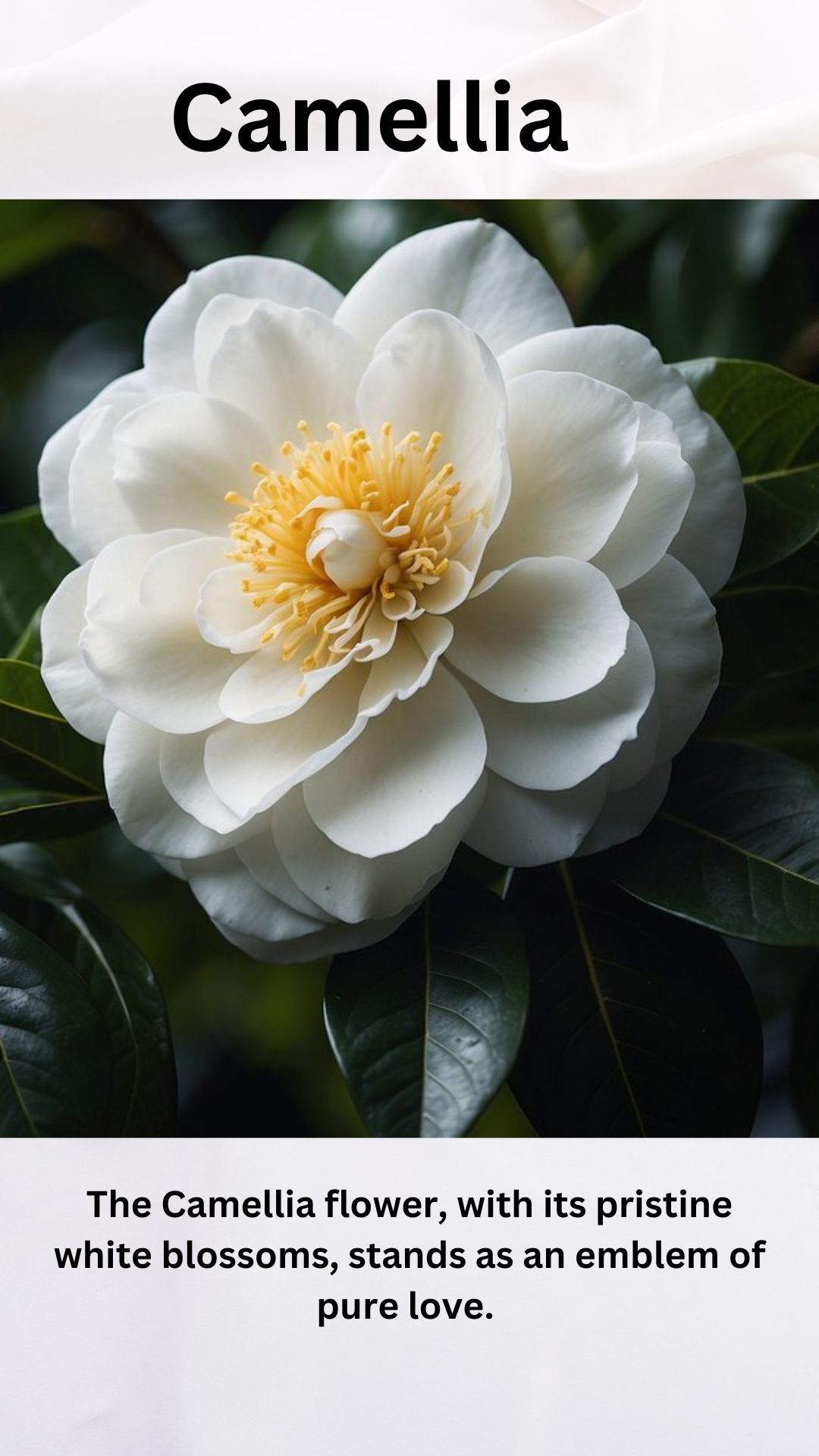
Meaning and Use Cases
The Camellia flower, with its pristine white blossoms, stands as an emblem of pure love. They embody purity, beauty, and are often linked to symbolism suggesting devotion and admiration. White Camellias resonate with messages of deep love, making them a perfect choice for bridal bouquets, symbolizing the pure and sweet start of a matrimonial journey.
Sun Requirements
Camellias thrive when given the perfect balance of light and shade. They prefer dappled sunlight, enjoying protection from the harsh midday rays. A spot that offers morning sunlight with afternoon shade will be the idyllic setting for these flowers to flourish.
Bloom Time
One can enjoy the splendor of Camellia’s bloom mainly during the fall to early spring. These hardy flowers provide a graceful display in cooler seasons when most other plants have ceased to show.
Soil Requirements
These elegant blooms require well-draining, acidic soil that is rich in nutrients. A pH between 5.5 to 6.5 is their sweet spot, ensuring they receive all the essential minerals without water retention, which could lead to root issues.
USDA Zone
Camellias are generally suited for USDA Zones 7 through 9, displaying their resilience to a range of temperate conditions.
To welcome the serene charm of the Camellia into gardens is to embrace a timeless beauty accompanied by a bouquet of meaningful symbolism. They enliven spaces with those courtly blossoms, making any garden a transcendentally enchanting realm.
Dahlia
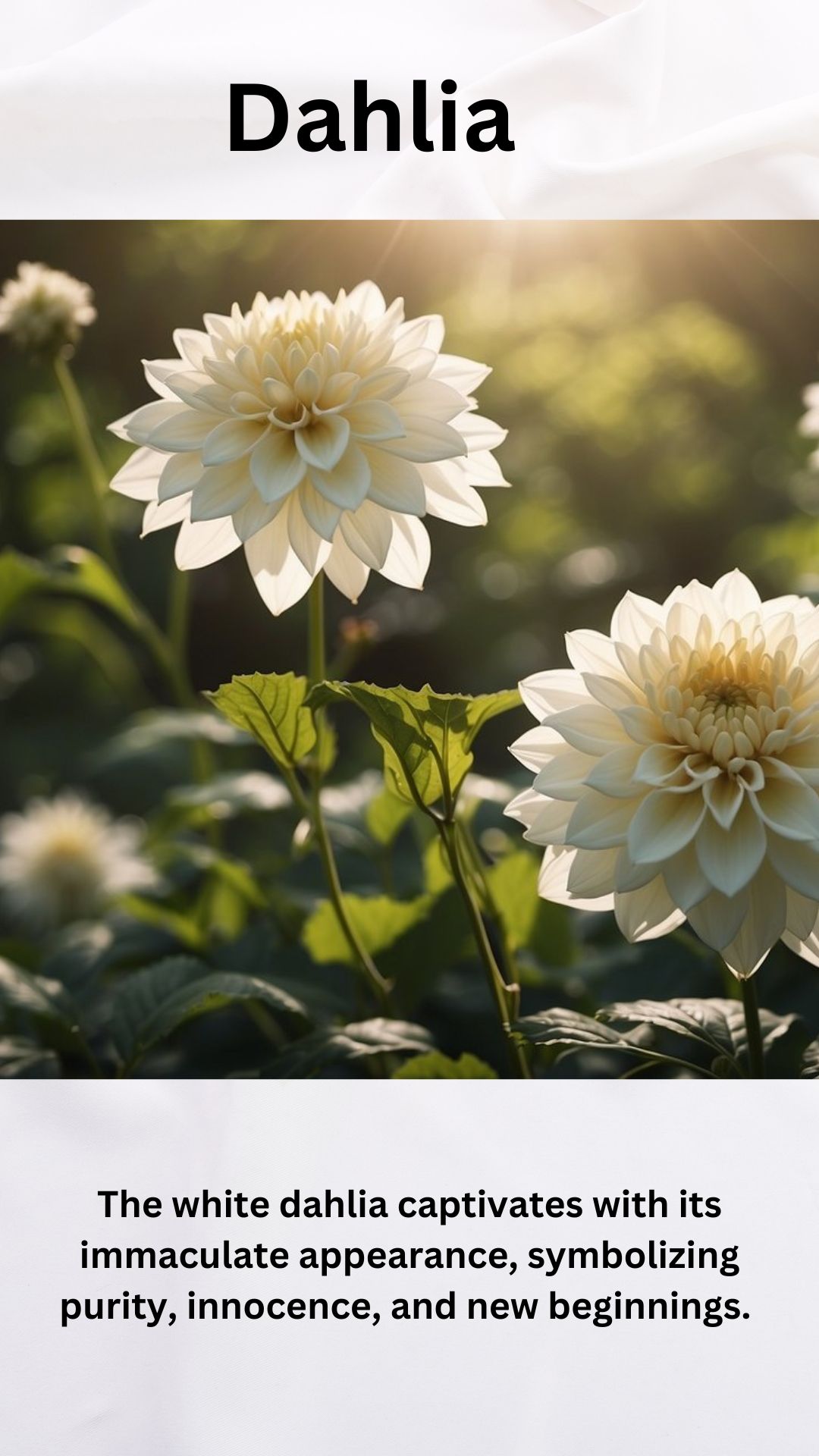
Meaning & Usage:
The white dahlia captivates with its immaculate appearance, symbolizing purity, innocence, and new beginnings. Florists and garden enthusiasts adore its grand, showy flowers for their stunning beauty and its evocation of a positive, fresh start. Among its many uses, the white dahlia shines brightest in celebratory floral arrangements, weddings, and as a comforting gesture to uplift someone’s spirit.
Sun Requirements:
These radiant blossoms bask in full sunlight. They thrive under the generous embrace of at least 6 hours of direct sunlight daily.
Bloom Time:
White dahlias boast an impressive bloom time, gracing gardens from midsummer until the first frosts of fall with their elegant presence.
Soil Requirements:
They demand well-drained soil that is moderately fertile. Ensure the soil has organic matter mixed in and maintains consistent moisture without becoming waterlogged. A neutral to slightly acidic pH between 6.5 and 7.0 suits them best.
USDA Zone:
White dahlias are hardy in USDA zones 8 to 11. With the right mulching and care, they can also be coaxed through colder climates, making them a versatile addition to many gardens.
In planting these lovely dahlias, one not only enriches their garden with a visually stunning flower but also with blooms rich in symbolism and versatility.
White Hydrangea
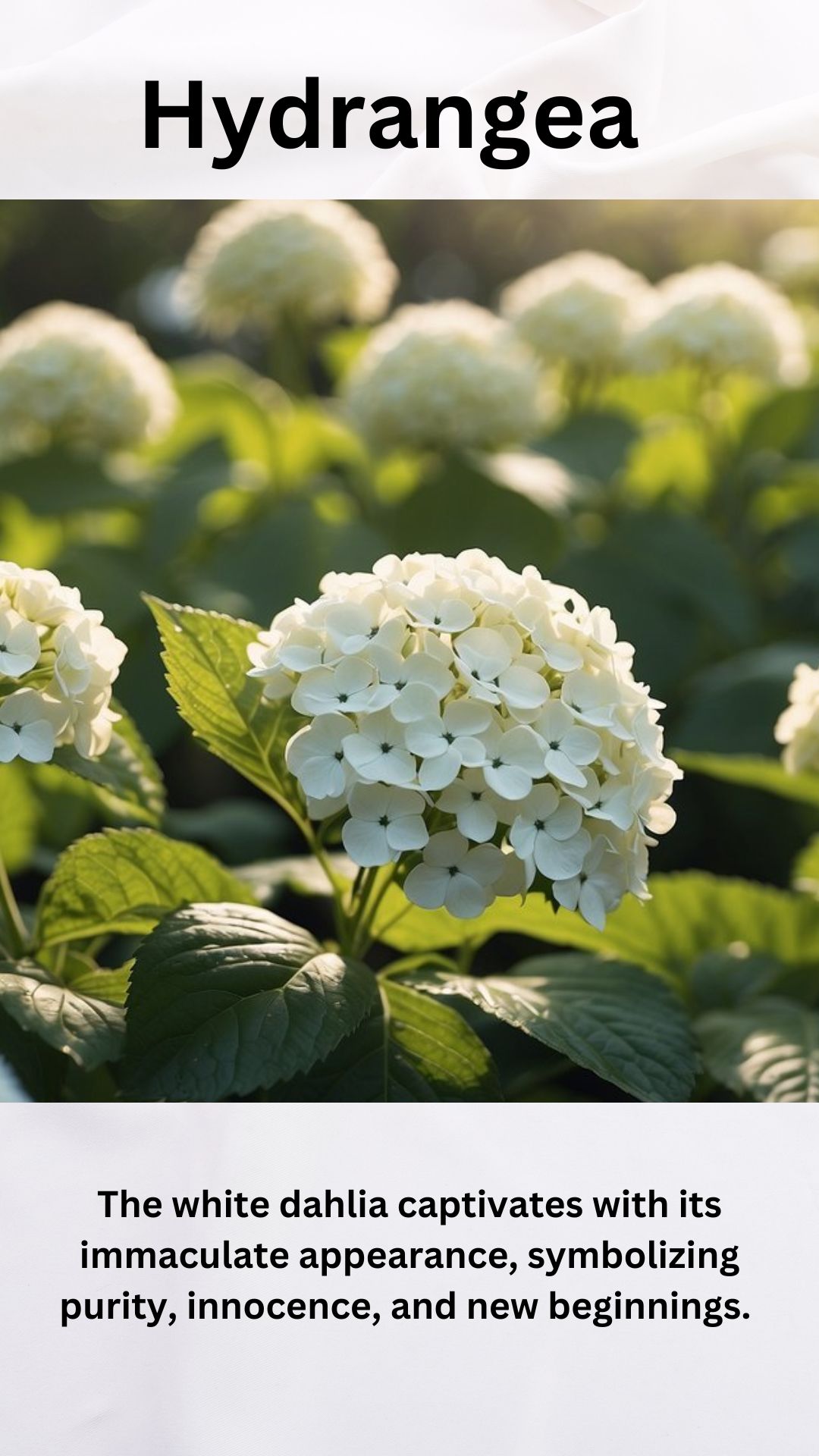
The white hydrangea is an enchanting flower, steeped in symbolism and functionality. Known for its large, round clusters of white blossoms, it’s a popular choice for weddings and gardens, symbolizing purity, grace, and abundance. Gardeners and event planners favor these stunning blooms for their opulent appearance and the touch of elegance they add to any setting.
Sun Requirements:
White hydrangeas prosper when they are planted in a location that receives morning sunlight and is sheltered from the intense afternoon heat. This balance of light ensures that they bloom profusely while maintaining their vibrant white color.
Bloom Time:
These flowers are summer highlights, showcasing their beauty during the warmer months. Their prime blooming period is a time of intensity, with full, lush heads of floral splendor gracing gardens.
Soil and Water Requirements:
| Soil Type | Moisture | pH |
|---|---|---|
| Fertile | Well-drained | Slightly acidic to neutral |
The white hydrangea thrives in fertile, well-draining soil. It prefers a slightly acidic to neutral pH but is known for its adaptability in various soil conditions.
Consistent watering helps maintain their lushness, particularly during their growth and blooming phases.
USDA Zones: They are hardy in a range of environments, suitable for USDA zones 5 through 9. This adaptability makes them ideal for a variety of landscapes across many regions.
In every petal and leaf, white hydrangeas carry centuries-old stories and symbolisms, making them not just plants, but bearers of timeless legacies. They add a spirit of celebration and reverence wherever they grow or grace a vase, from gardens to gala events.
Calla Lily

The Calla Lily exudes an air of elegance with its trumpet-shaped blooms, synonymously heralding purity and grace.
In bridal bouquets, they’re a stunning choice, symbolizing the innocence and devotion of a love that’s about to embark on the sacred journey of matrimony.
Sun Requirements: Calla Lilies thrive best when they receive full sun to partial shade.
Their ideal day consists of basking in bright morning rays, sheltered from the harsh afternoon glare.
Bloom Time: Enchanting observers from late spring to summer, they flourish into a spectacle of refined beauty, unfurling their petals as nature’s crafted masterpiece.
Soil Requirements:
- pH Level: Slightly acidic to neutral; pH 6.0–7.0 is optimal.
- Drainage: Well-drained soil is crucial for preventing tuber rot.
USDA Zone: Hardy in USDA zones 8 to 10, they display their resilience by adapting to their environment. They can also be grown in colder zones with proper winter care.
Culturally, they’re revered in various traditions, serving as emblems of protection and healing.
Gardeners are enticed by their array of colors, although for the traditionalist, nothing says timeless beauty quite like the classic white Calla Lily.
Whether illuminated by the golden sun or cradling the morning dew, they are a symbol of peace and a favorite among florists and garden enthusiasts alike.
White Orchid

The striking beauty of the White Orchid often symbolizes purity, perfection, and spiritual enlightenment.
Frequently chosen for weddings, these blooms epitomize the union of two individuals into harmonious matrimony.
In addition, their serene appearance can represent a desire for tranquility and mental clarity.
Meaning and Use Cases
- Purity and Perfection: Ideal for nuptial celebrations
- Spiritual Enlightenment: Often associated with places of worship
- Calmness and Clarity: Desire for peace in one’s environment
Sun Requirements
White Orchids thrive in bright, indirect sunlight.
They enjoy light but should be shielded from the harsh, direct afternoon sun to avoid damage to their delicate petals.
Bloom Time
These orchids typically bloom once a year. Each flower spike houses up to 25 flowers that can last for weeks, offering an extended display of their breathtaking elegance.
Soil Requirements
They prefer a well-draining orchid potting mix that allows for proper air circulation around the roots. This ensures adequate moisture without waterlogging.
USDA Zone
While specifics can vary by species, many White Orchids do well in USDA zones 12 and above.
They flourish in humid and warm climates but can be grown indoors under controlled conditions in cooler zones.
The mere presence of a White Orchid turns a common room into a space of sophistication, its every bloom a testament to nature’s masterful design.
Whether perched high on an elegant stand or gracing a simple windowsill, the White Orchid commands admiration.
White Hibiscus
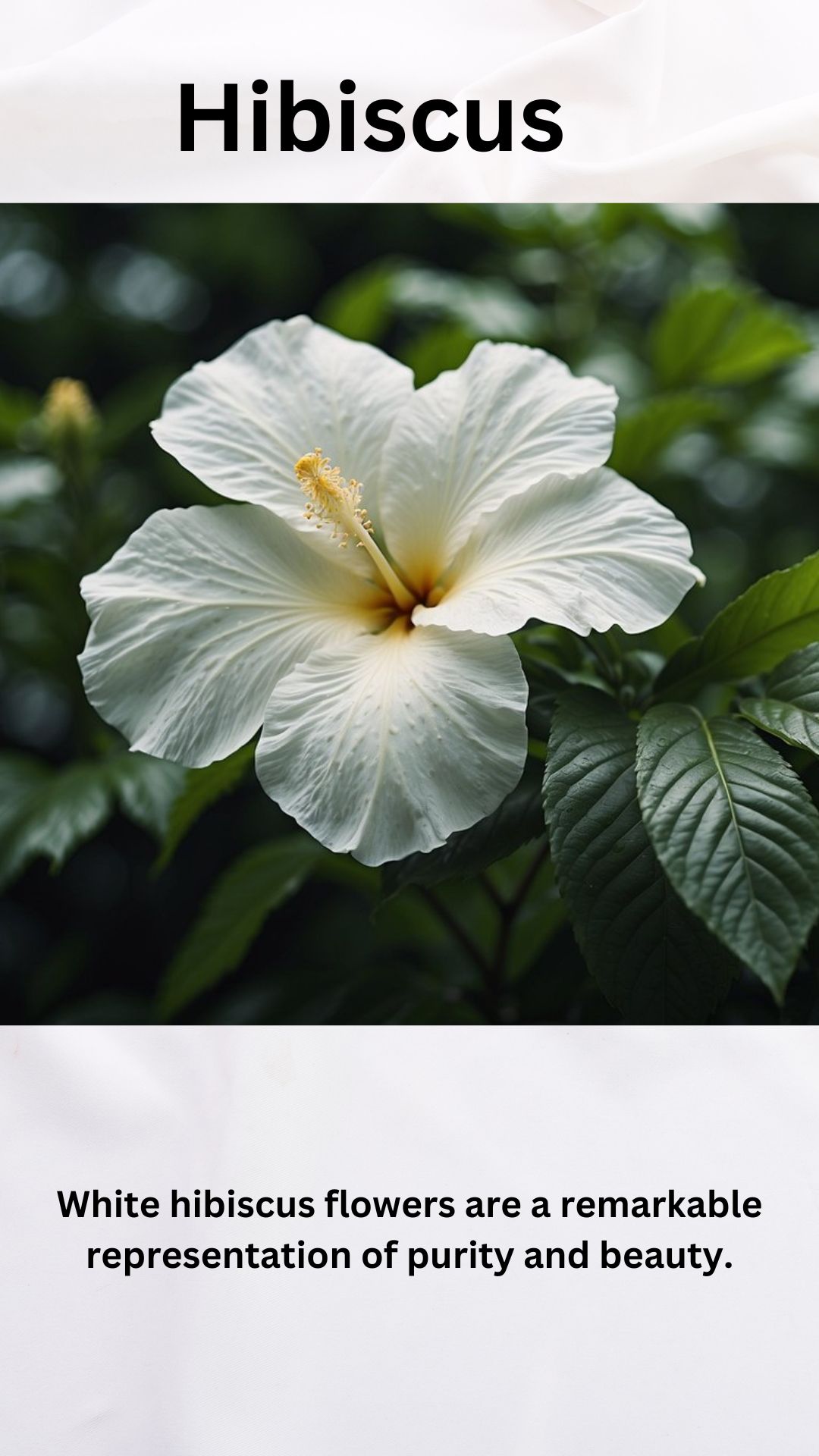
White hibiscus flowers are a remarkable representation of purity and beauty.
They exude an air of elegance that captivates plant enthusiasts and gardeners alike.
Known not only for their aesthetic appeal, these blooms carry profound symbolism, often associated with purity, innocence, and new beginnings.
They are also an emblem of respect and acknowledgment, making them ideal for a variety of ceremonial uses.
Beyond their symbolism, white hibiscus flowers thrive in full sunlight, making them perfect for sun-drenched gardens.
They flourish during the warm summer months, providing an extended bloom time that enlivens any space they grace.
Thanks to their robust nature, they have become a staple in both private gardens and public landscapes.
Sun Requirements: Full sunlight
Bloom Time: Summer
Soil Requirements: Well-draining, moderately moist soil
USDA Zone: 5-8
Plant lovers keen on creating an alluring garden space often turn to the white hibiscus for its impressive and meaningful blooms.
Its captivating beauty, coupled with its rich symbolism, positions the white hibiscus as a cherished feature in gardens around the world.
White Peony
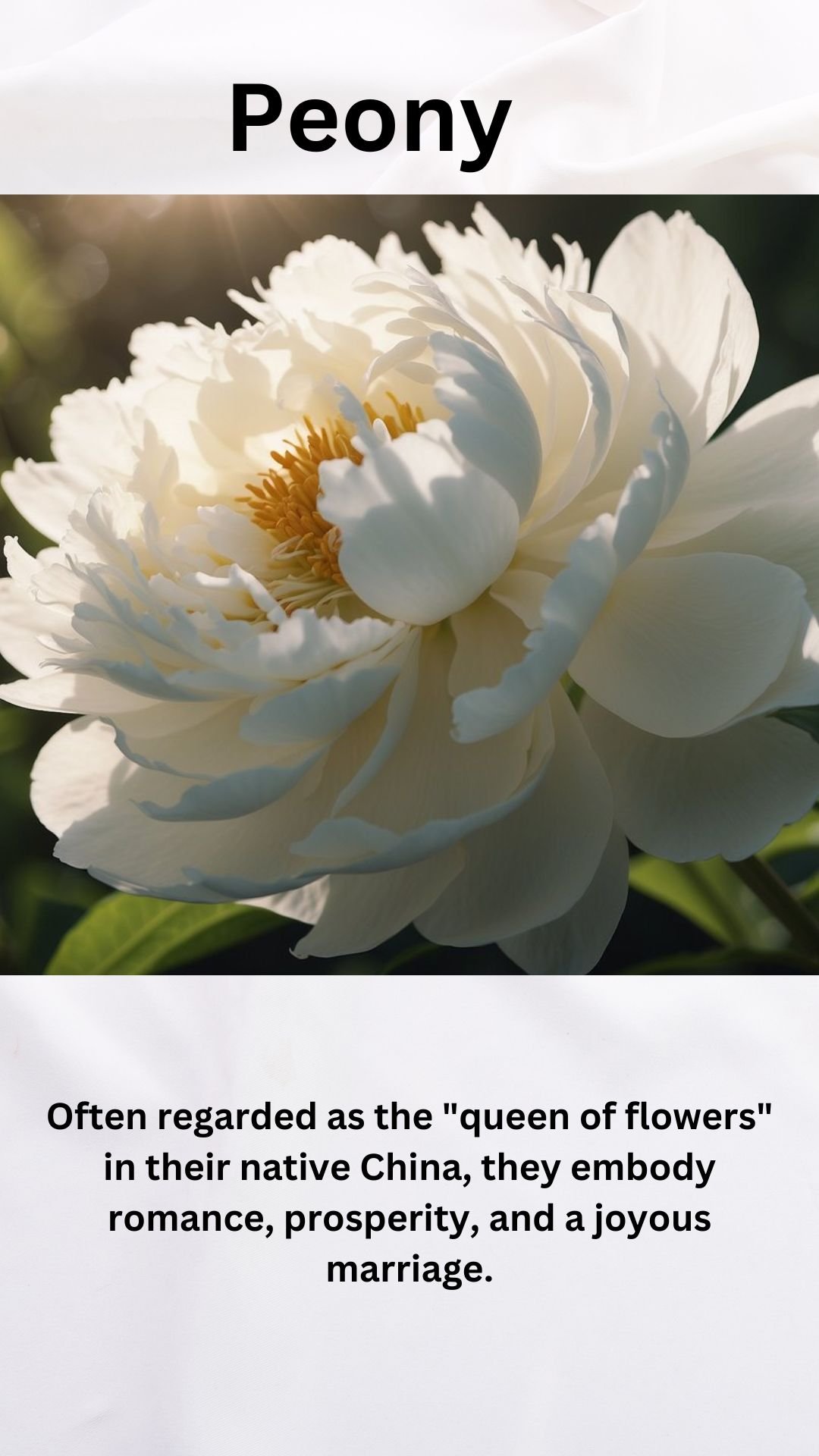
White peonies, with their full, rounded blooms, are a symbol of beauty and grace.
Often regarded as the “queen of flowers” in their native China, they embody romance, prosperity, and a joyous marriage.
Gardeners and floral enthusiasts admire white peonies for their lush appearance and deep-rooted cultural significance, spanning from mythological tales to contemporary wedding bouquets.
Meaning and Use Cases
White peonies are steeped in symbolism. They are the go-to flower for expressing romance and compassion, while also being a harbinger of good luck.
Their medicinal properties are renowned too, especially in traditional Chinese medicine where the root treats various ailments.
Sun Requirements
- Full Sun to Partial Shade
Bloom Time
- Early Spring to Early Summer
Soil Requirements
- Well-drained, moist, fertile soil
USDA Zone
- 3-8
Here are some captivating varieties and their enchanting attributes:
- ‘Bowl of Cream’: Its name reflects the lush, full blooms reminiscent of a brimming bowl of sweet cream. This variety thrives under full sun to partial shade and blooms majestically.
- ‘Henry Sass’ & ‘Miss America’: These award-winners stun with pure white petals. They demand attention in any garden, basking in full sun to partial shade.
The white peony’s versatility in both symbolism and horticultural requirements makes it a treasured choice for gardens and floral arrangements across the world.
Enthusiasts eagerly anticipate their bloom season, as they transform gardens into tranquil sanctuaries.
Stephanotis
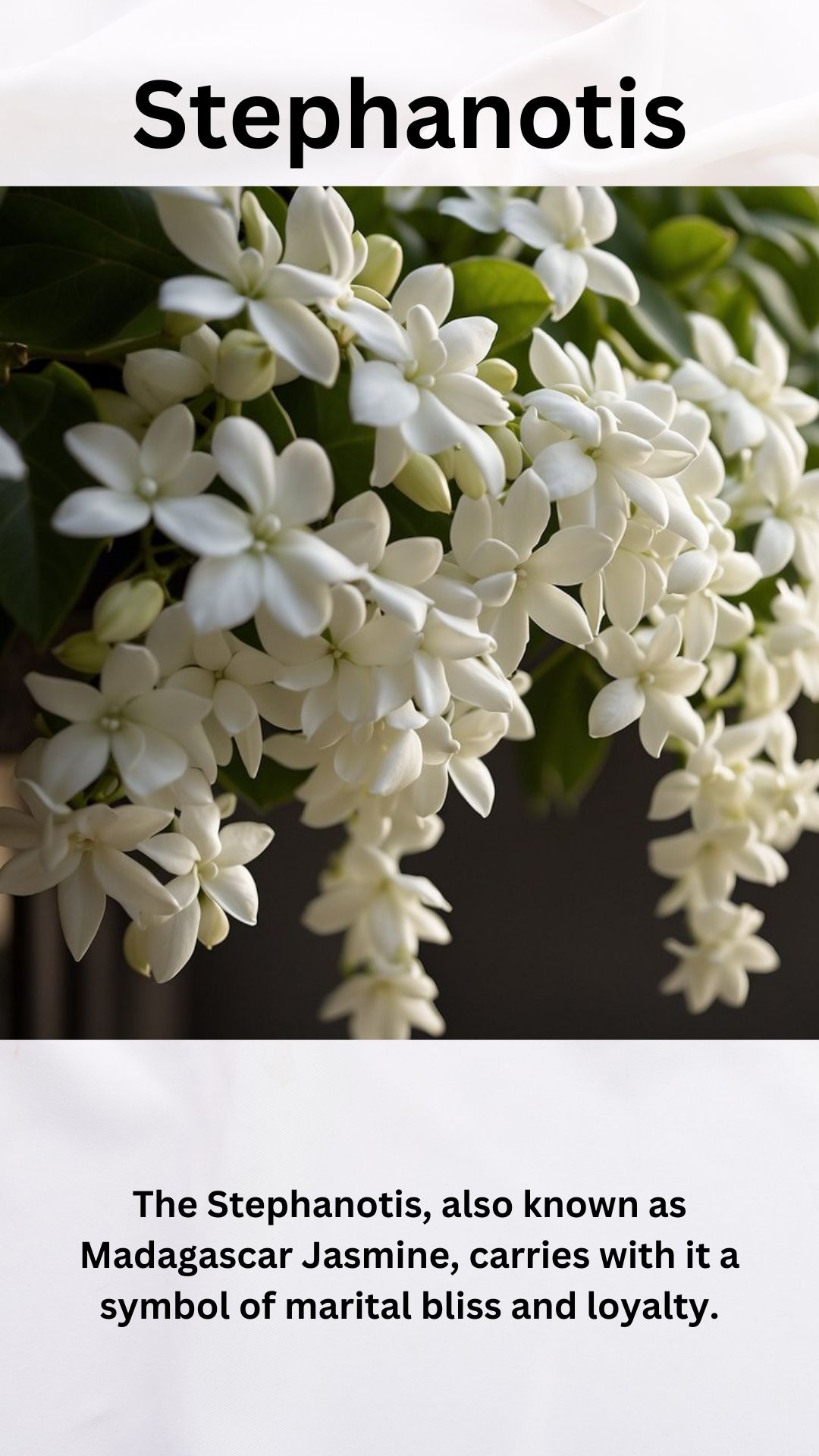
Meaning and Uses
The Stephanotis, also known as Madagascar Jasmine, carries with it a symbol of marital bliss and loyalty.
These resplendent white flowers are a staple at weddings, adorning bouquets and decorations, conveying wishes for happiness and a faithful partnership.
Their purity and sweet scent enhance their role as a messenger of good fortune and enduring love.
Sun Requirements and Bloom Time
Stephanotis thrives in bright, indirect light but requires shielding from harsh, direct sunlight that can scorch its delicate petals.
This plant graces the warm season with its blossoms, primarily blooming from spring through fall.
Soil Requirements
A well-draining, rich potting mix is a must for Stephanotis, mirroring the loamy soil of its native habitat.
Adding peat moss or perlite can increase the drainage and aeration of the soil, providing an optimal growing condition.
USDA Zone
Ideally, Stephanotis should be grown in USDA zones 10-11. In these climates, it has the best chance to flourish outdoors year-round.
Gardeners in cooler zones often keep it as a potted plant that can be moved indoors during colder months to protect its tropical nature.
Stephanotis invites gardeners to not only enjoy its aesthetic charm but also to infuse spaces with the spirit of adventure and warm sentiments of well-wishing.
Their care requirements are a worthy trade-off for the joy and beauty they bring to any occasion.
White Carnation
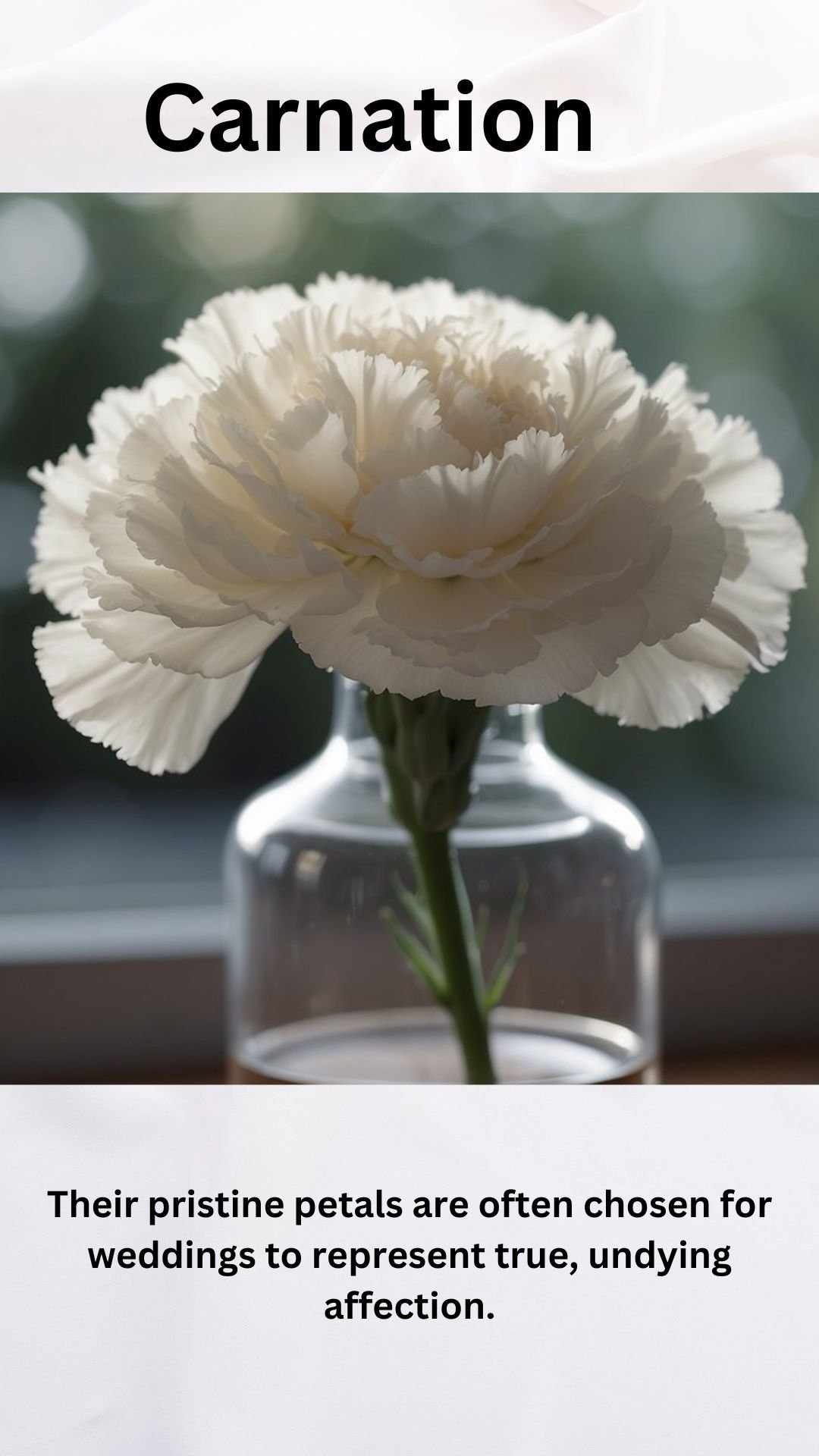
White carnations are a symbol of pure love and good fortune. Their pristine petals are often chosen for weddings to represent true, undying affection.
They’re also a popular fixture in arrangements for other heartfelt events such as christenings and funerals where they signify new beginnings and eternal life. These flowers are more than decorative; they convey sincere emotions.
Sun Requirements: White carnations thrive in full sun to part shade.
They bask gleefully in at least six hours of sunlight a day, fostering tight, ruffled blooms that brighten gardens and bouquets alike.
Bloom Time: These flowers are known for their generous blooming period, gracing gardens with their presence typically from late spring until early fall, offering a long-lasting show of beauty.
Soil Requirements: They prefer well-drained, fertile soil. A mix that is slightly alkaline to neutral pH keeps these flowers thriving.
USDA Zone: White carnations are hardy in USDA zones 6 through 9. They flourish in areas with milder winters and not-too-extreme summers.
Cultivating this floriferous plant provides a spectacle of sweet and spicy scents, and when cared for properly, they become the gardener’s pride.
Its blooms are an enduring favorite for their versatility and deep-rooted meanings that touch hearts on any occasion.
White Magnolia
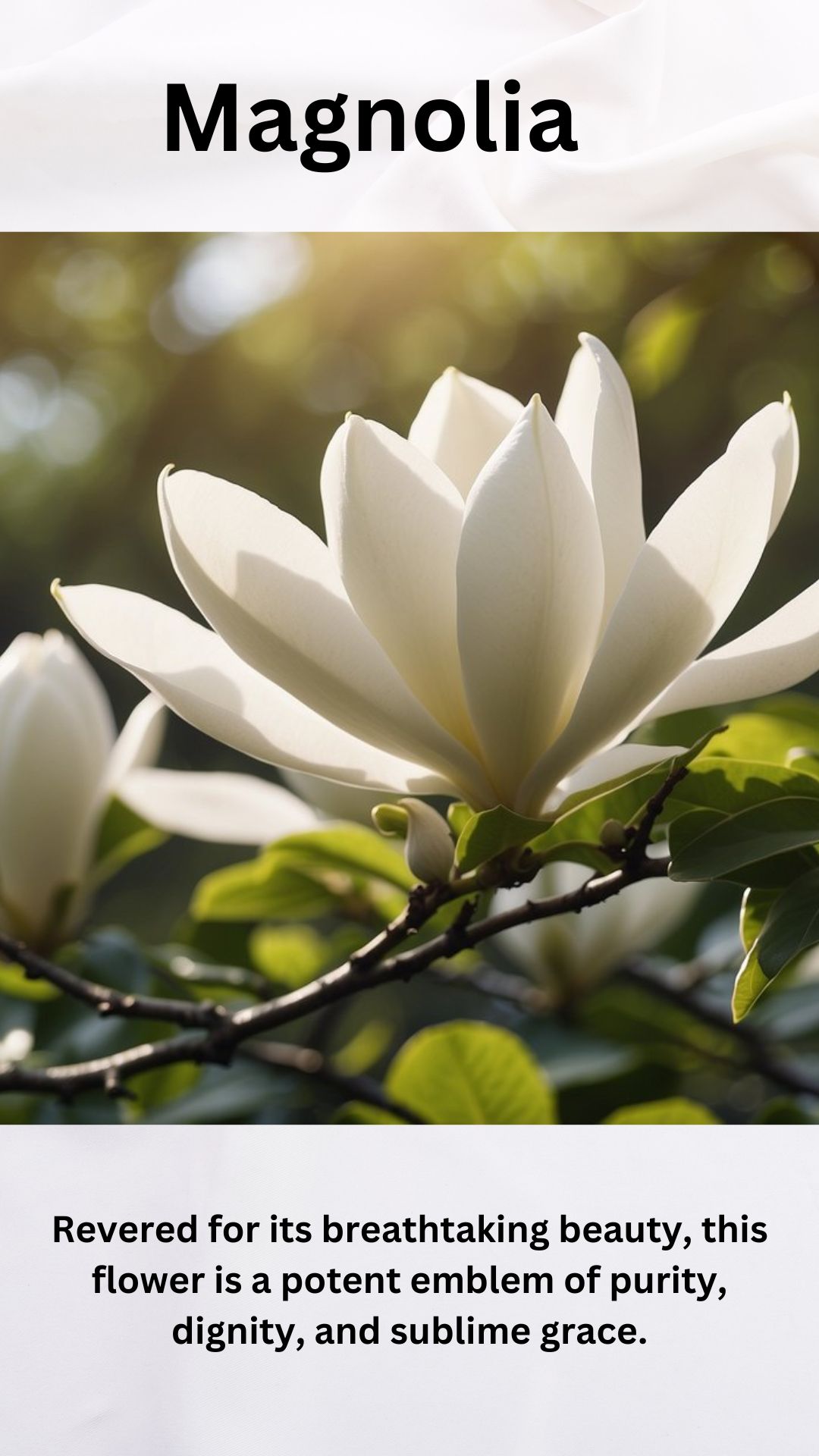
The White Magnolia, with its creamy, porcelain-like petals, radiates an aura of elegance and tranquility.
Revered for its breathtaking beauty, this flower is a potent emblem of purity, dignity, and sublime grace.
Bridal bouquets and wedding decor often feature the white magnolia, as it embodies the purity of love and the deep connection shared by the newlyweds.
Sun Requirements: White Magnolias flourish under full sun exposure, basking in the warmth to unfurl their splendid blooms.
Bloom Time: The arrival of spring ushers in the white magnolia’s bloom period, transforming gardens into a picturesque display of floral radiance.
Soil Requirements: They thrive in rich, well-drained soil that is slightly acidic, requiring adequate moisture to maintain their lush foliage and stunning flowers.
USDA Zone: White Magnolias are hardy in zones 6-9, where they can reach their full potential and adorn the landscape with their captivating presence.
Gardeners and nature enthusiasts eagerly await the blooming of the magnolia, as it signals the rejuvenating energy of spring and carries profound symbolic meanings.
They are not only pillars of visual allure in the garden but also impart an inviting fragrance that can be subtly reminiscent of citrus and licorice. “>
Sweet Alyssum
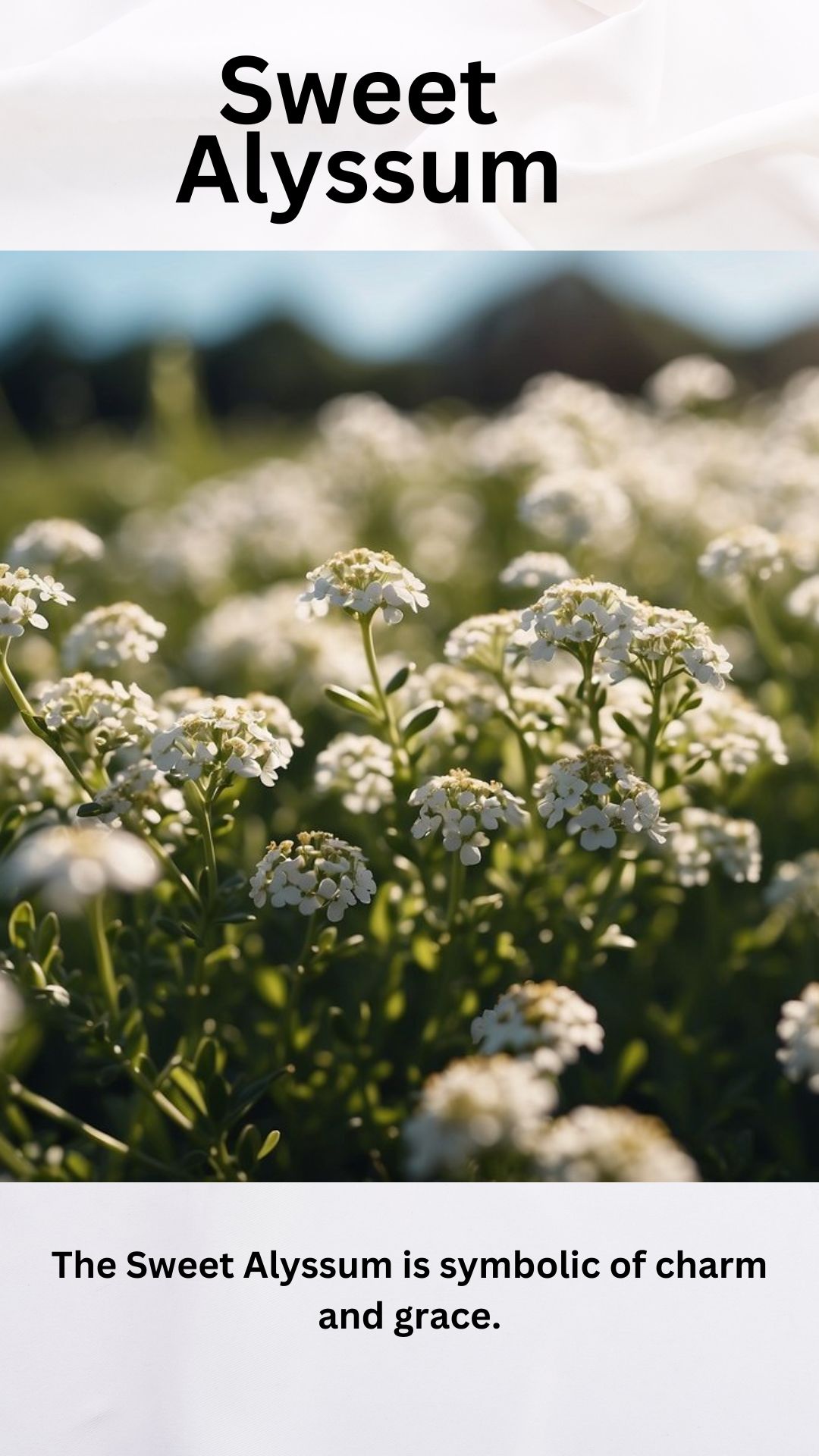
Sweet Alyssum, also known as Lobularia maritima, is a charming and fragrant addition to any garden.
These delightful flowers carry deep meanings of beauty and calmness, serving as a beacon of sweetness in various settings from borders to container gardens.
Meaning and Use Cases:
The Sweet Alyssum is symbolic of charm and grace. In past times, Greeks would incorporate this quaint bloom in ceremonies to honor Venus, the goddess of love.
Its captivating scent and petite clusters make it a popular choice for wedding bouquets and as a filler in floral arrangements, adding a touch of delicate elegance.
Sun Requirements:
- Full sun to partial shade
Bloom Time:
- Spring through fall
Soil Requirements:
- Well-draining soil
- Prefers neutral to slightly alkaline pH
USDA Zone:
- Hardy in USDA Zones 4 through 9
Gardeners admire Sweet Alyssum for its resilience and ability to spread a carpet of snow-like flowers.
They flourish under bright sun but also tolerate partial shade, basking in the glory of sunlight while enduring cooler climes.
Their longevity from spring till the brushes of autumn frost provides a perennial sense of joy and beauty.
When it comes to soil, they are not picky but perform best in soils that drain well to prevent waterlogging.
Adaptable to various pH levels, they still favor a neutral to a mildly alkaline environment.
Thriving mainly in USDA Zones 4 to 9, they weave a tapestry of serenity across a wide range of climates.
This plant’s simplicity in care and the powerful symbolism it carries make it a treasure for gardeners and flower enthusiasts alike.
Baby’s Breath
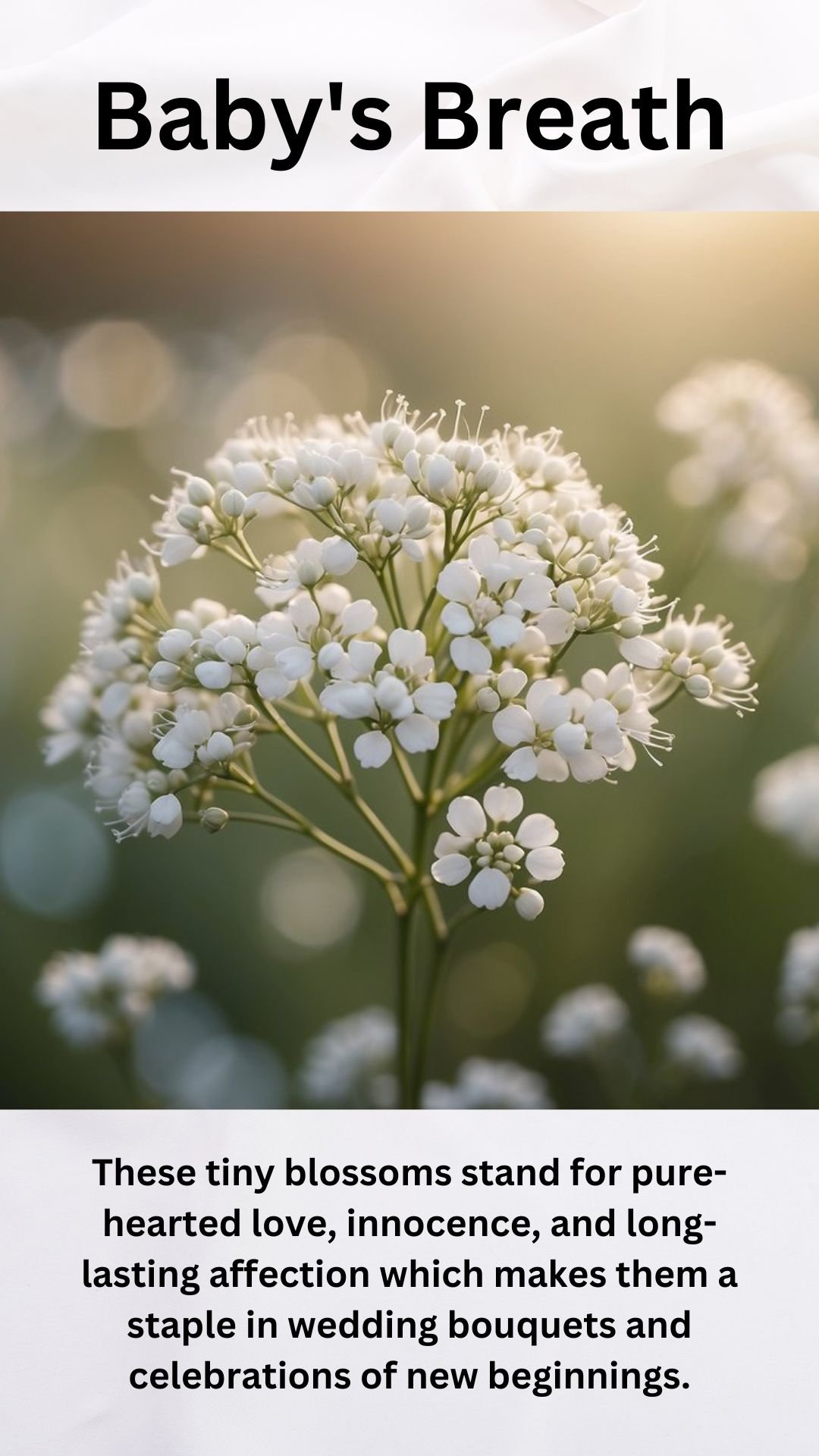
Baby’s Breath, scientifically known as Gypsophila, blooms into a cloud of dainty white flowers that carry with them the breath of symbolism and elegance.
These tiny blossoms stand for pure-hearted love, innocence, and long-lasting affection which makes them a staple in wedding bouquets and celebrations of new beginnings.
Meaning and Uses:
- Symbolism: Represents enduring love and purity.
- Usage: Favoured for weddings and as filler in floral arrangements.
Growing Requirements:
- Sun: Prefers full sun to thrive.
- Bloom Time: Flowers typically appear in the late spring and summer.
- Soil: Well-draining, neutral to slightly alkaline soil is best.
- USDA Zone: Grows well in zones 3 to 9.
Anyone with a garden space or a sunny spot indoors can enhance their environment with Baby’s Breath.
As they watch these resilient flowers fill their space with frothy beauty, gardeners rejoice in the effortless charm they add.
With soil that drains well and ample sunshine, Baby’s Breath flourishes, gracing gardens with their bloom from late spring into the warm embrace of summer.
A symbol of innocence, these flowers impress in their hardiness, tolerating various environments as long as they are rooted within USDA zones 3 to 9.
With minimal care and an unassuming nature, Baby’s Breath confidently claims its presence in both cultivation and sentiment, forever carving a niche as a bearer of happiness and purity.
White Azalea
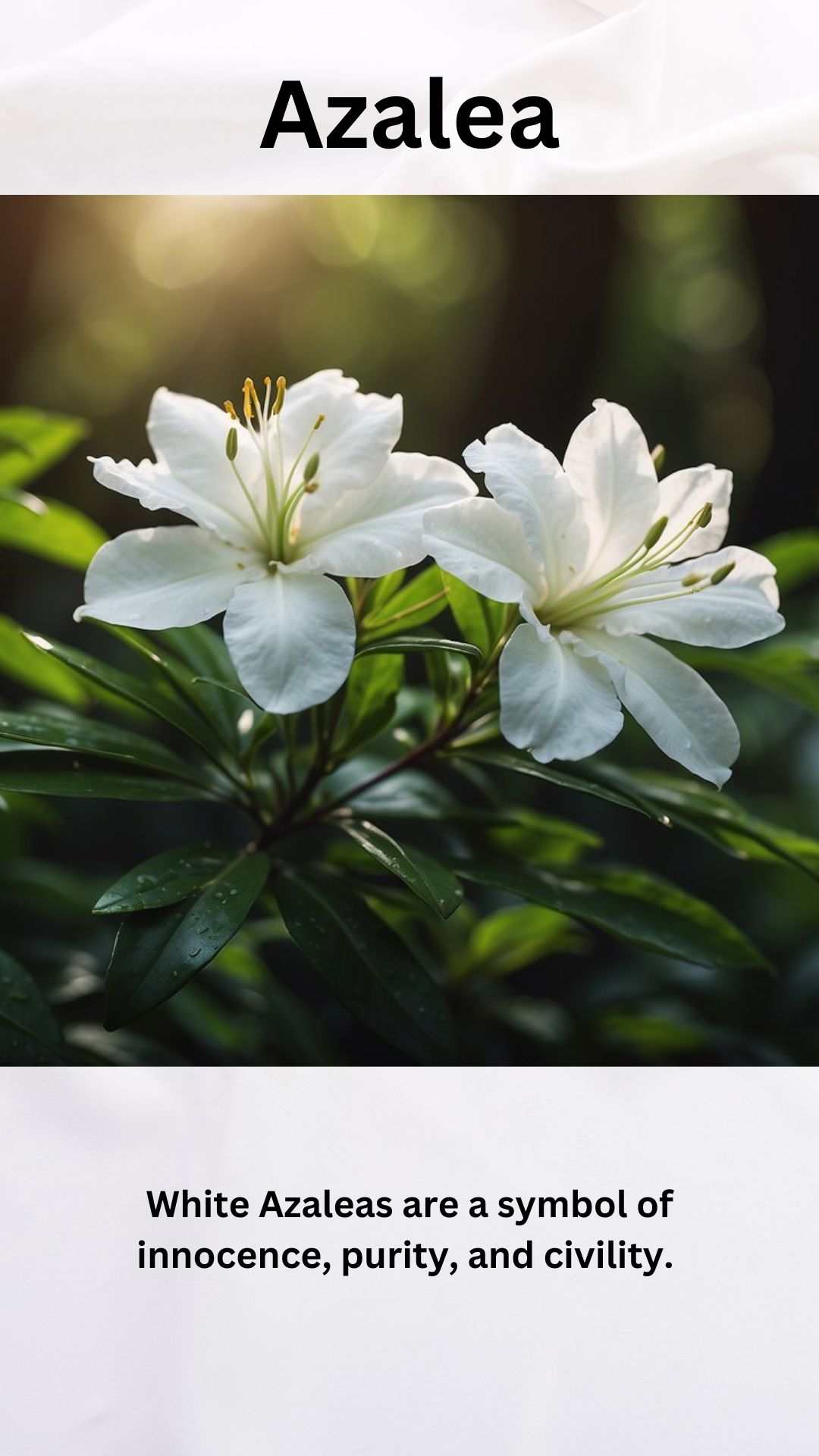
White Azaleas are a symbol of innocence, purity, and civility. Their pristine blossoms are often sought after to convey a message of temperance or to express sympathetic sentiments.
Meaning and Uses The White Azalea flower is celebrated for its medicinal qualities. In traditional Chinese medicine, people use it to tackle respiratory ailments. Beyond their medicinal uses, these flowers are also a popular choice in gardens for their cultural significance and elegance.
Sun Requirements White Azaleas thrive in partial sun. Too much direct sunlight can be detrimental to their growth. So, they should be planted in a spot where they can enjoy some shade, especially during the hottest parts of the day.
Bloom Time These captivating flowers typically bloom in springtime. They adorn gardens with their vibrant white petals for several weeks.
Soil Requirements These flowers favor well-drained, moist soil that is rich in organic matter. An acidic soil pH between 4.5 and 6.0 is ideal for White Azaleas to flourish.
USDA Zone White Azaleas are generally hardy in USDA zones 6 through 9. They demonstrate resilience to a variety of climates within these regions.
- Medicinal Properties: Traditional Chinese medicine for respiratory issues.
- Cultural Significance: Symbolizes purity and femininity.
- Sunlight: Prefers partial sun and some shade.
- Bloom Time: Celebrates spring with several weeks of bloom.
- Soil: Enjoys acidic, well-drained, and organically rich soil.
- Hardiness: Thrives in USDA zones 6-9.
White Anemone
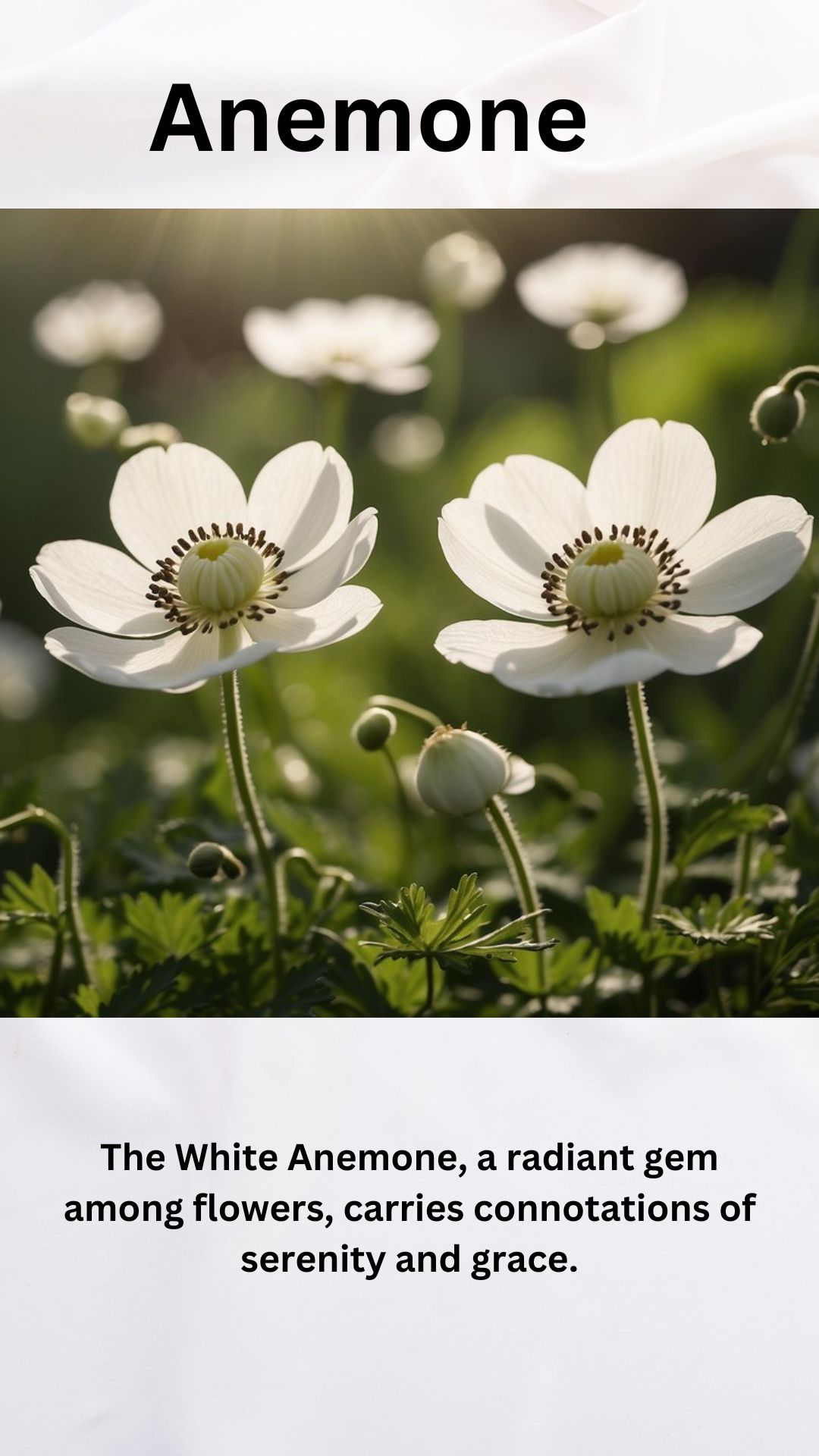
The White Anemone, a radiant gem among flowers, carries connotations of serenity and grace. Its petals represent a tapestry of meanings from peace to protection, making it an excellent choice for momentous events.
At weddings, these blossoms symbolize purity, while at memorial services, they offer consolation and remembrance.
White Anemones flourish under partial sun to light shade, catering to gardeners who favor gentler sunlight conditions.
Their bloom time showcases nature’s timeliness, with flowers unfurling their splendor from late winter to early spring, a treat for eyes weary from winter’s monochrome palette.
These flowers prefer well-draining soil, a balance that promotes healthy growth without waterlogged roots.
To thrive, one should plant them in USDA zones 4 through 8, ensuring a climate conducive to their well-being.
- Meaning & Use Cases: Peace, tranquility, purity, protection
- Sun Requirements: Partial sun to light shade
- Bloom Time: Late winter to early spring
- Soil Requirements: Well-draining
- USDA Zone: 4 to 8
Gardeners embrace the White Anemone for its balance and harmony, as it brings a touch of the ethereal to the earth.
Its delicate presence is a herald of the coming spring and the cyclical nature of renewal and hope.
White Chrysanthemum
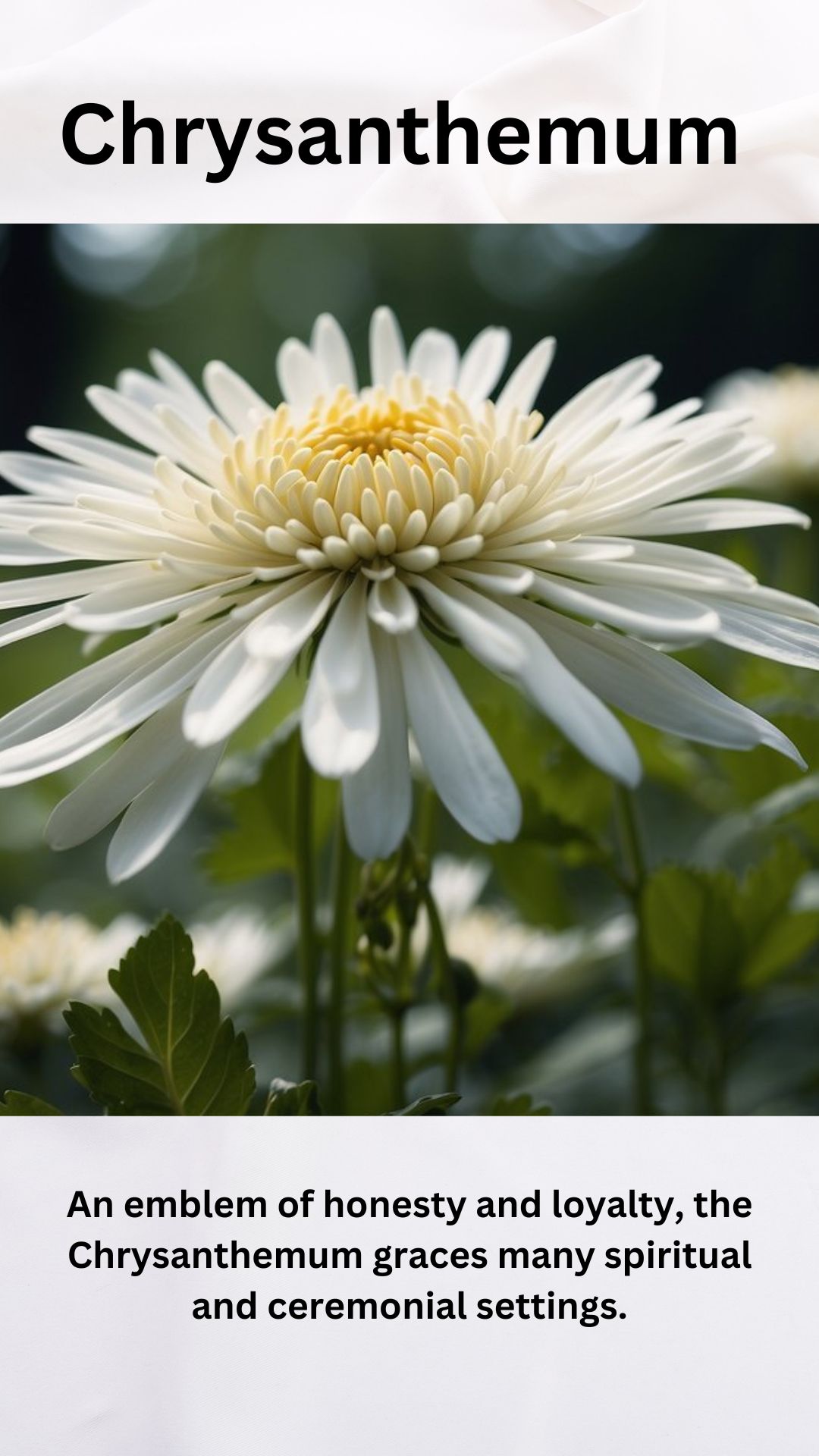
The White Chrysanthemum, a flower of purity and bereavement, holds deep symbolic weight. Its pristine petals reflect innocence with a grace that few flowers can match. This bloom is often chosen to honor a lost loved one or convey sympathy.
An emblem of honesty and loyalty, the Chrysanthemum graces many spiritual and ceremonial settings.
Cultivation Delights:
Basking in the full glory of the sun, this flower thrives under the benevolent rays. They prefer a spotlight but will forgive partial shade.
Mums bloom effusively in the late summer to fall, providing a calm and serene flourish to the garden’s end-of-season tapestry.
Growing Requirements:
- Sun: Full sun to partial shade
- Bloom Time: Late summer to fall
- Soil: Well-drained, nutrient-rich
- USDA Zone: Typically 5-9
The soil should be welcoming, rich in nutrients, and well-drained, ensuring that each root has a refreshing drink without being drowned.
Gardeners are rewarded in zones 5 through 9, where chrysanthemums settle in with ease, asking only for an occasional drink and a bit of tending.
The White Chrysanthemum is not just a floral emblem but an ecological wonder that thrills gardeners with its low maintenance and reliable grace.
It reminds one and all of the temporary nature of life while steadfastly returning each year with renewed beauty.
White Lilac
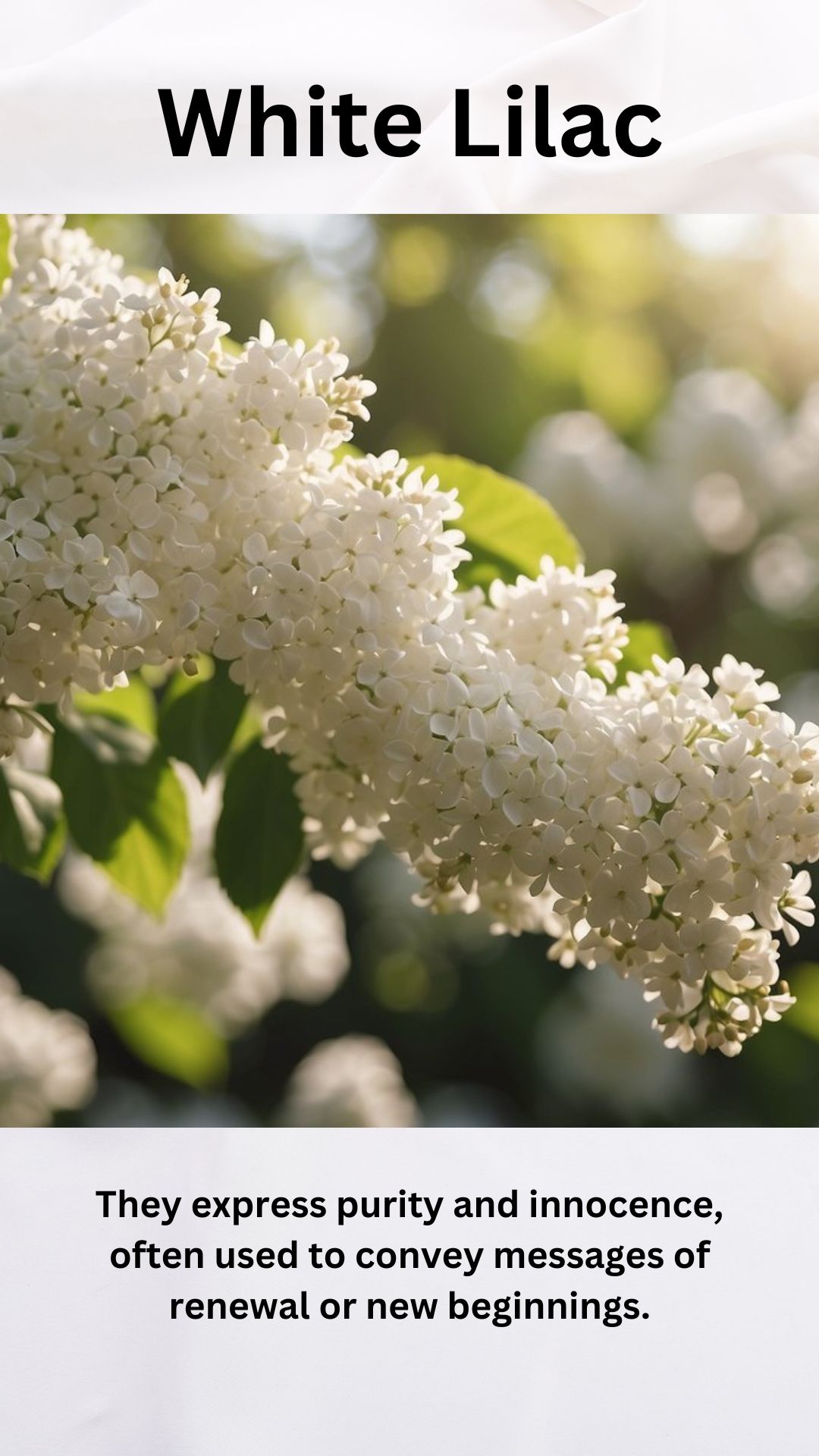
White lilacs are a delightful sight, exuding an air of purity, innocence, and hope. Renowned for their enchanting fragrance, these flowers symbolize renewal and the joy of youth, making them a heartwarming addition to any space.
Meaning and Use Cases:
White lilacs hold a place of honor in the language of flowers. They express purity and innocence, often used to convey messages of renewal or new beginnings.
Due to their serene color and appealing scent, they are perfect for weddings and springtime events.
Sun Requirements:
These charming blossoms thrive in full sun to partial shade. They favor the warmer days of spring, basking in the sunlight to unfurl their petals.
Bloom Time:
The white lilac’s bloom time is a herald of spring. They grace gardens with their presence in late spring, filling the air with their signature fragrance.
Soil Requirements:
White lilacs prefer well-drained, humus-rich soil. They enjoy a slightly alkaline to neutral pH, ensuring their robust growth.
USDA Zone:
Suited to USDA zones 3 through 7, white lilacs are hardy and adaptable, capable of enduring a range of climates while maintaining their elegance.
- Sunlight: Full sun to partial shade
- Bloom Season: Late spring
- Ideal Soil: Well-drained, humus-rich
- pH: Slightly alkaline to neutral
- USDA Zones: 3-7
White lilacs beckon gardeners and flower enthusiasts alike with their captivating aroma and symbolic significance.
They stand as an emblem of purity, making them much more than just a pretty flower. They are a treasure in any garden, promising beauty and a sense of renewal each year.
White Gerbera Daisy
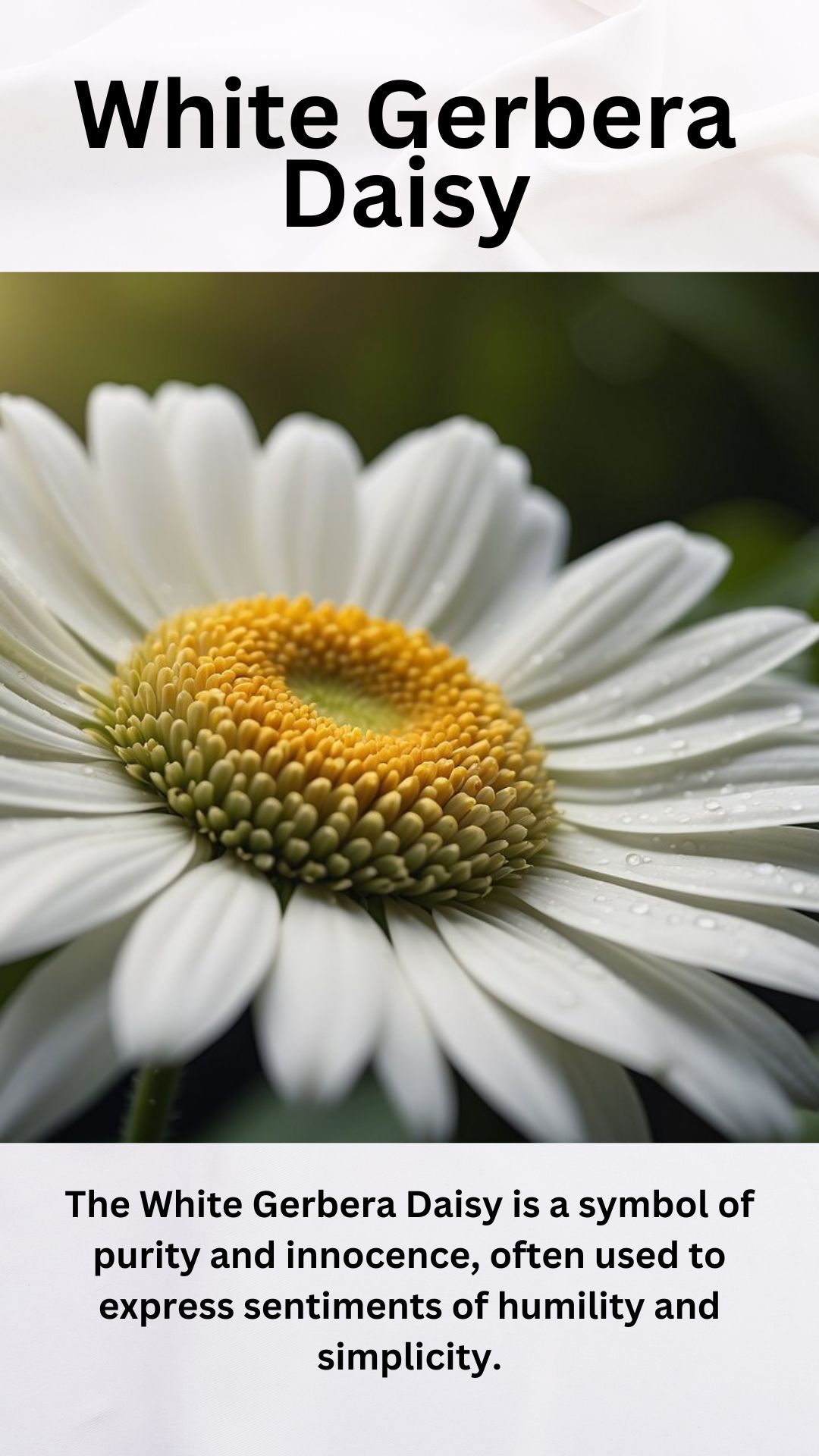
The White Gerbera Daisy is a symbol of purity and innocence, often used to express sentiments of humility and simplicity.
Known for representing pure love, these charming flowers offer a sense of calm and serenity to any space. They are a popular choice in various arrangements, embodying the essence of chastity and innocence within their striking white petals.
Sun Requirements:
- Full sun to partial shade
Bloom Time:
- Spring to autumn
Soil Requirements:
- Well-draining, fertile, and able to maintain a balanced moisture level
USDA Zone:
- Thrives in zones 9-11
Use Cases:
- Bridal bouquets to convey purity
- Sympathy arrangements representing tranquility
- Festive decor symbolizing joy and cheer
Gardeners and floral enthusiasts are drawn to the White Gerbera Daisy’s versatility and vibrant spirit.
They grow best under the generous warmth of the sun, with the bloom period stretching impressively from spring through to fall.
The soil must strike a perfect balance, neither too dry nor too waterlogged, demonstrating the flower’s preference for a nurturing environment.
Nestled comfortably in zones 9 through 11, it spreads its gentle radiance.
Whether gracing a wedding or bringing peace during somber times, the White Gerbera Daisy is a beacon of heartfelt emotions and everlasting beauty.
Its radiant blooms open to the sky, welcoming observers to partake in the joy it naturally exudes.
With every petal, they unfold a message of hope and innocence, an exciting addition to any garden or floral composition.
White Poppy
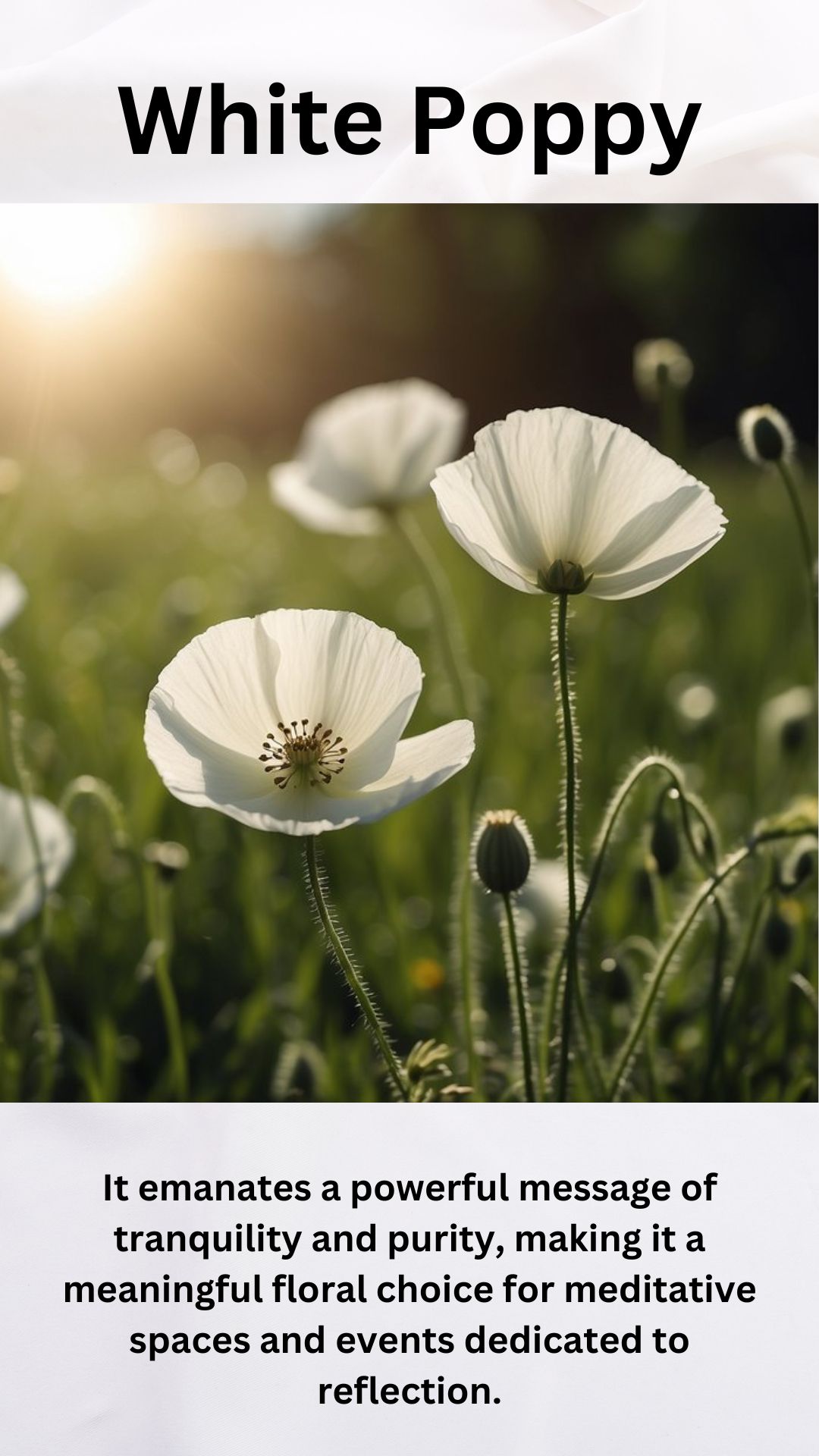
Meaning and Symbolism
The White Poppy stands out with its bright, serene petals symbolizing peace and remembrance. It emanates a powerful message of tranquility and purity, making it a meaningful floral choice for meditative spaces and events dedicated to reflection.
In terms of use cases, they’re adored in both simple and elegant floral arrangements and are particularly impactful in designs that aim to convey a message of peace.
Sun Requirements
This flower thrives best in full sunlight, which is vital for their growth and the vibrancy of their delicate white petals.
Bloom Time
White Poppies bloom beautifully in the late spring to early summer, providing a fresh and calming presence that fits perfectly with the awakening of the season.
Soil Requirements
They prefer well-drained soil with moderate fertility. Ensuring the soil is not too waterlogged is key to maintaining healthy White Poppies.
USDA Zone
These flowers are suited to a range of climates and are typically hardy in USDA zones 3 through 9.
- Peace and Purity: Represents inner peace and enlightenment.
- Versatile in Arrangements: Ideal for bouquets to complex centerpieces.
- Full Sun: Requires bright, direct light to prosper.
- Late Spring Bloomer: Creates a seasonal spectacle with their flowering.
- Soil: Thrives in well-drained, moderately fertile soil.
- USDA Zones: Hardy between zones 3 to 9.
White Poppies are a gift to any garden, carrying not just their beauty but also a deep meaning that resonates in their blooming presence.
White Zinnia
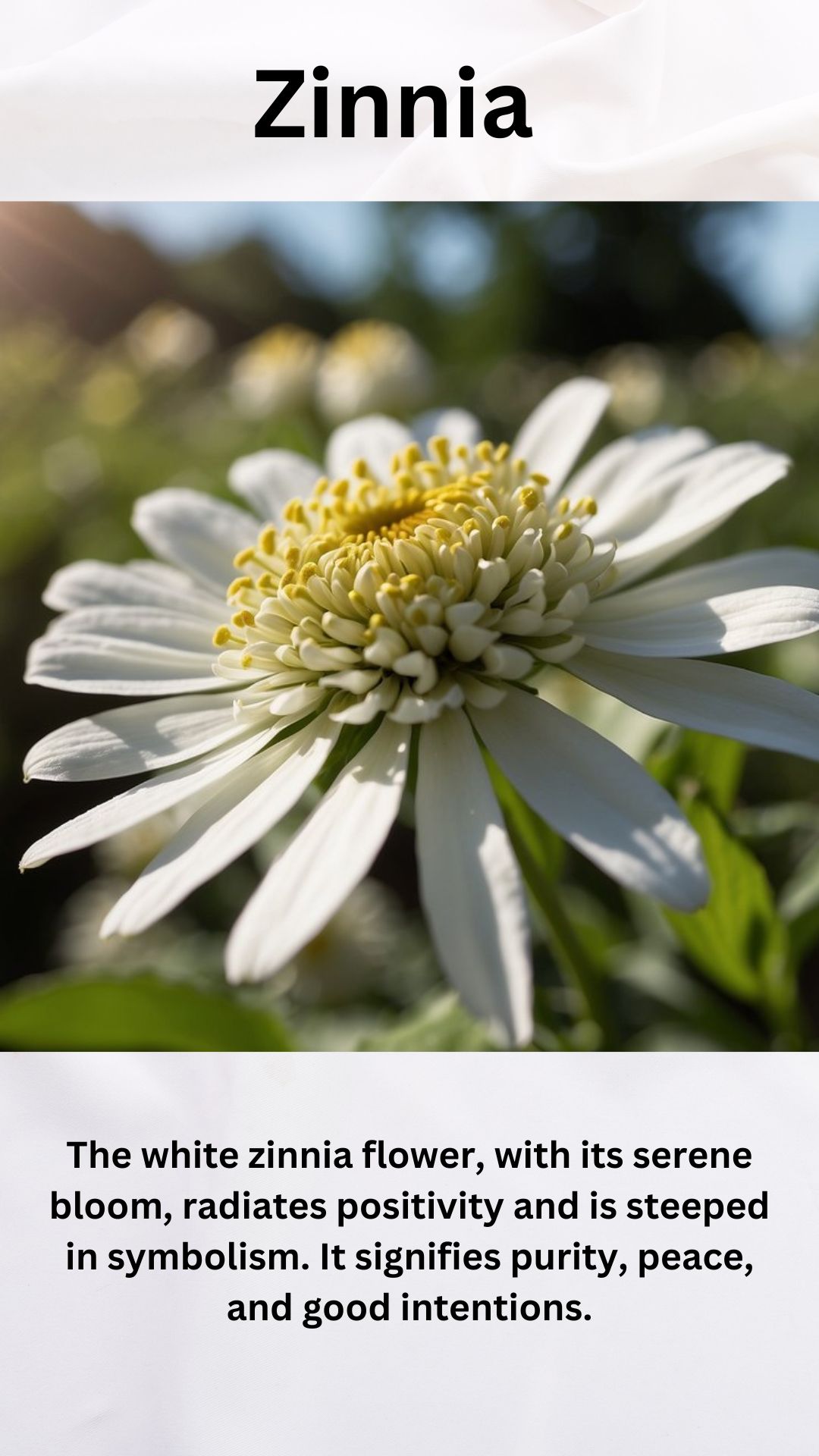
Meaning and Use Cases
The white zinnia flower, with its serene bloom, radiates positivity and is steeped in symbolism. It signifies purity, peace, and good intentions.
Due to these associations, people often use white zinnias in bouquets to convey pure thoughts, well wishes, and to create a peaceful ambiance.
In addition, its bright presence is believed to encourage freedom, light, and progress.
Sun Requirements
White zinnias thrive in full sunlight. They require exposure to ample sunlight to develop their full potential, making them perfect for sunny gardens.
Bloom Time
These delightful flowers celebrate the warmer months by blooming from spring through fall. They offer a sustained display of beauty, bringing joy throughout the seasons.
Soil Requirements
For optimal growth, white zinnias favor well-drained soil. They are adaptable but they perform best in rich, loamy soil that keeps their roots healthy.
USDA Zone
Zinnias are hardy in USDA zones 2 through 11, which allows them to be cultivated in a wide range of climates.
Table of White Zinnia Features
| Feature | Description |
|---|---|
| Symbolism | Purity, Peace, Good Intentions |
| Sunlight | Full Sun |
| Bloom Time | Spring to Fall |
| Soil | Well-drained, Loamy |
| USDA Zone | 2 – 11 |
White zinnias’ versatility and symbolic value make them a cherished addition to any garden or floral arrangement.
Their lasting bloom is a testament to endurance and the continual pursuit of growth and enlightenment.
White Marigold

Meaning and Use Cases:
The White Marigold, particularly the Kilimanjaro White variety, blankets gardens in purity and elegance.
Symbolizing new beginnings and serenity, it’s a beautiful choice for white-themed gardens and is often used in celebrations that call for a touch of solemnity and grace, such as weddings.
The velvety, cream-colored blooms also represent healing and support, making them suitable for sympathy arrangements.
Sun Requirements:
White Marigolds bask in full sunlight. They thrive when they can soak up at least six hours of direct, unfiltered daylight each day.
Bloom Time:
They typically unfurl their petals in the warmth of summer and will continue to charm onlookers until the first sign of frost.
Soil Requirements:
These low-maintenance beauties aren’t fussy, but they do prefer well-drained soil.
Ensuring that they have a bed of fertile, loamy earth goes a long way in supporting their growth.
USDA Zone:
Despite their delicate appearance, White Marigolds are hardy as annuals in USDA Zones 2a through 11b.
These stunning marigolds are adaptable, showcasing their resilience by flourishing across a wide geographical range.
In the garden, White Marigolds not only infuse space with a serene ambiance but also serve as a beacon of light, flanked by vibrant greens.
Whether planted en masse or tucked between other annuals, they command attention with their creamy blossoms and bring a dynamic contrast to any floral tapestry.
White Foxglove
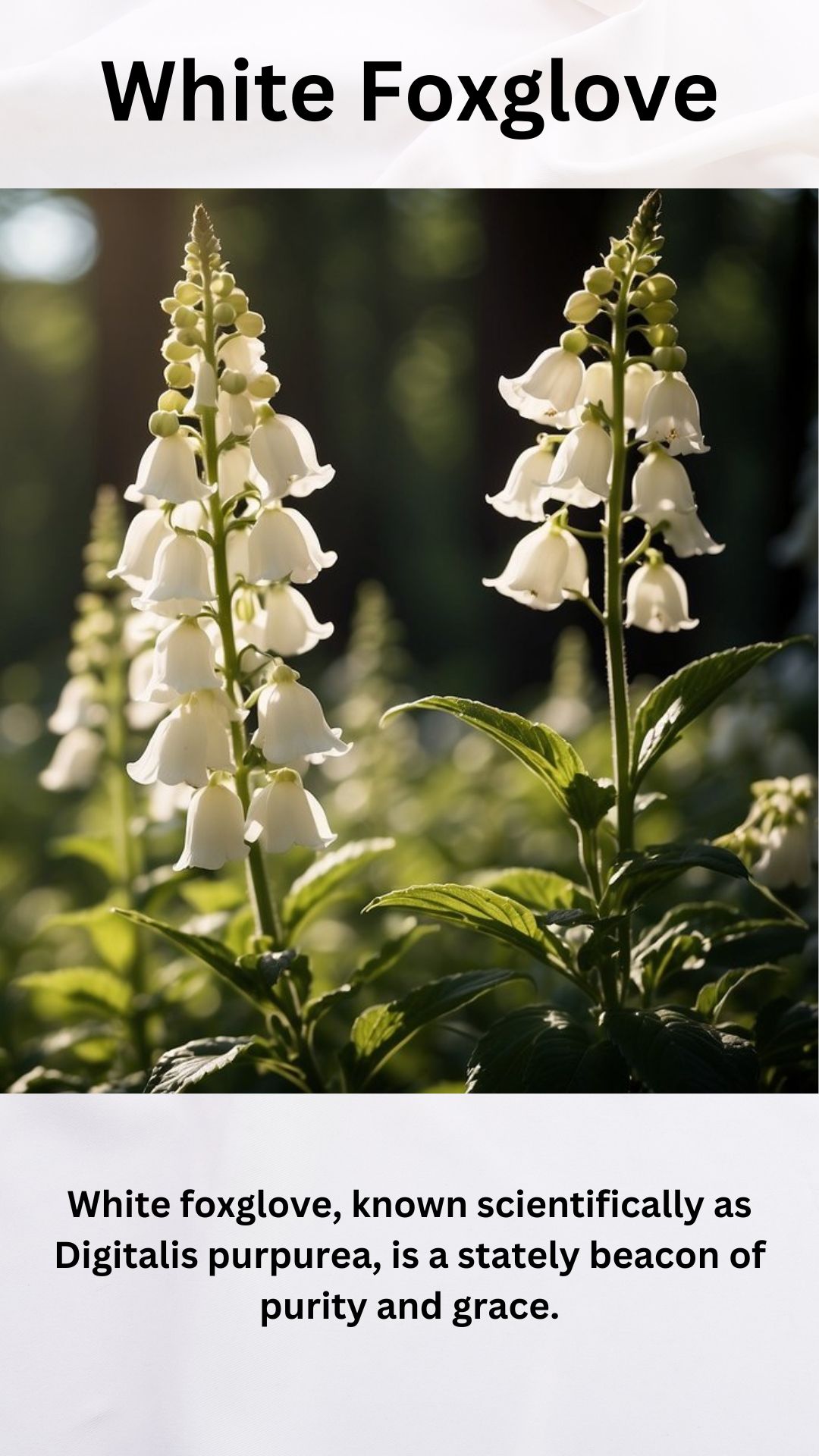
White foxglove, known scientifically as Digitalis purpurea, is a stately beacon of purity and grace. It flourishes in full sun to partial shade, basking in the glow of the sunlight as it brings a dash of elegance to any garden.
The blooms of white foxglove make their grand appearance in late spring to early summer, a time when the air is sweet with the promise of warm days.
Ideal Soil and Climate Conditions:
- Soil: Well-drained, moist soil is best.
- USDA Zone: Thrives in zones 4 to 9.
White foxglove carries profound symbolism; it is revered for representing divine love and purity of heart. The charming bell-shaped florets are not just a visual treat but also embody innocence and spirituality.
Uses in Gardens and Landscapes:
- Backdrops: Perfect for the back of a border or as part of a woodland garden.
- Pollinators: Attracts bees, providing a sanctuary for these essential garden visitors.
Gardeners should note that while it holds symbolic gentility, all parts of the plant are toxic if ingested. However, when used responsibly, it has a heritage in folk medicine. Historically, extracts from the foxglove plant have been used to craft heart medications, thanks to the plant’s naturally occurring digitoxin.
This majestic biennial ensures that a garden will not only captivate the senses with its serene beauty but will also be cloaked in layers of symbolic meaning and practical use. The white foxglove truly is a garden’s treasure, blending utility with splendor.
White Snapdragon
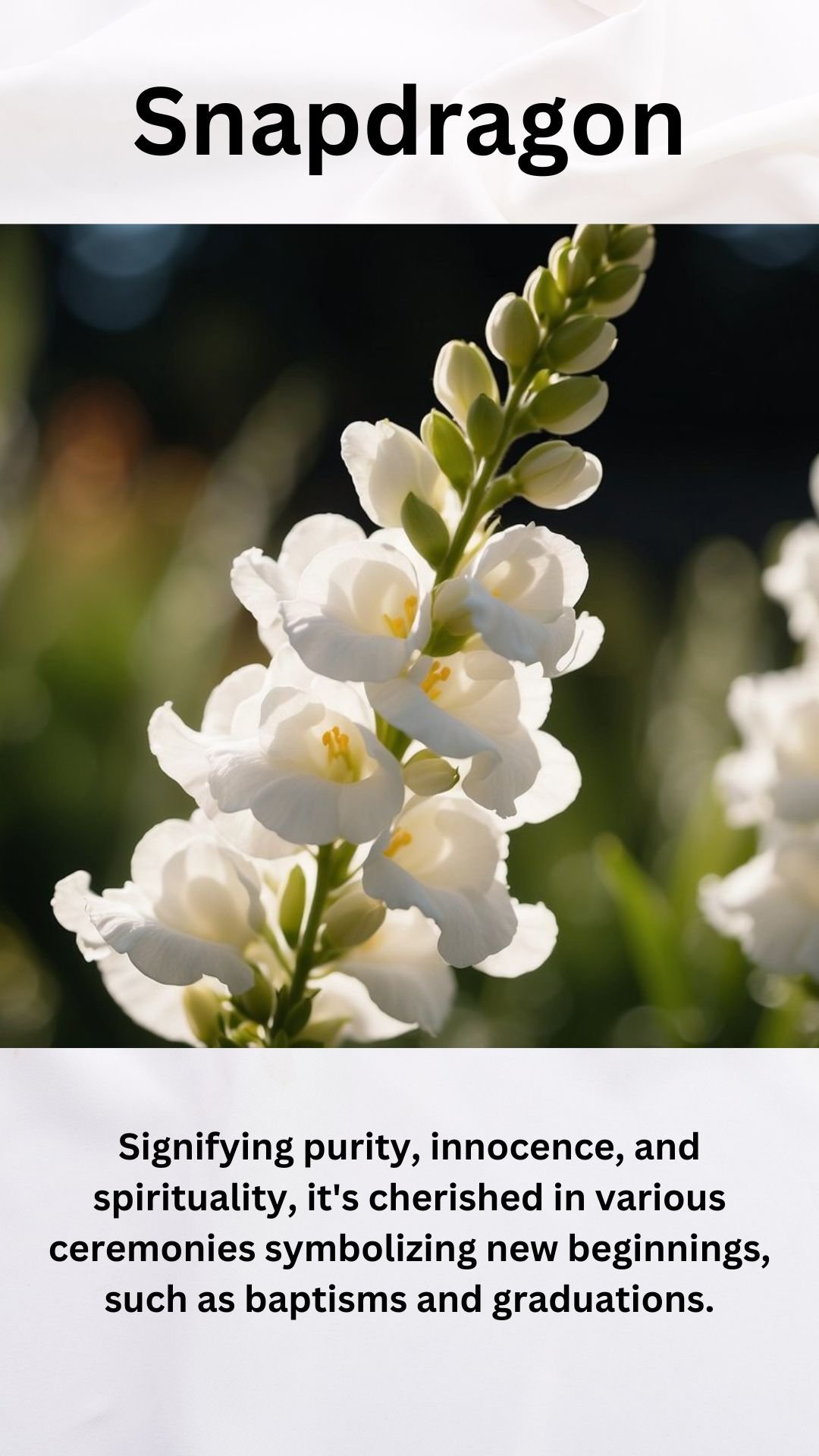
Symbolism and Uses
The White Snapdragon is a fixture in the language of flowers. Signifying purity, innocence, and spirituality, it’s cherished in various ceremonies symbolizing new beginnings, such as baptisms and graduations. The floral emblem of truth-telling from the Victorian Era, it carries a rich tradition within romantic and spiritual contexts.
Sunlight and Blooming
Thriving in full sun to partial shade, White Snapdragons are admired for their late spring to early fall bloom time. They offer a prolonged display of elegance, with their dragon-mouth shaped blooms dancing in the garden breeze.
Soil and Water Requirements
These flowers prefer moderately fertile, well-drained soil. Consistent moisture aids their growth, yet they require good drainage to avoid root rot. Amending the soil with organic matter can help in maintaining an ideal growing environment.
Climate Adaptation
White Snapdragons are hardy in USDA zones 7-11. They boast a strong root system making them resilient and capable of withstanding various weather conditions, including wet environments.
Chart of White Snapdragon Characteristics
| Characteristic | Detail |
|---|---|
| Meaning | Purity, innocence, spirituality |
| Sun | Full to partial shade |
| Bloom Time | Late spring to early fall |
| Soil | Moderately fertile, well-drained |
| USDA Zone | 7-11 |
White Snapdragons captivate gardeners with their serene beauty and adaptable nature, making them a beloved addition to a diverse array of gardens.
White Impatiens
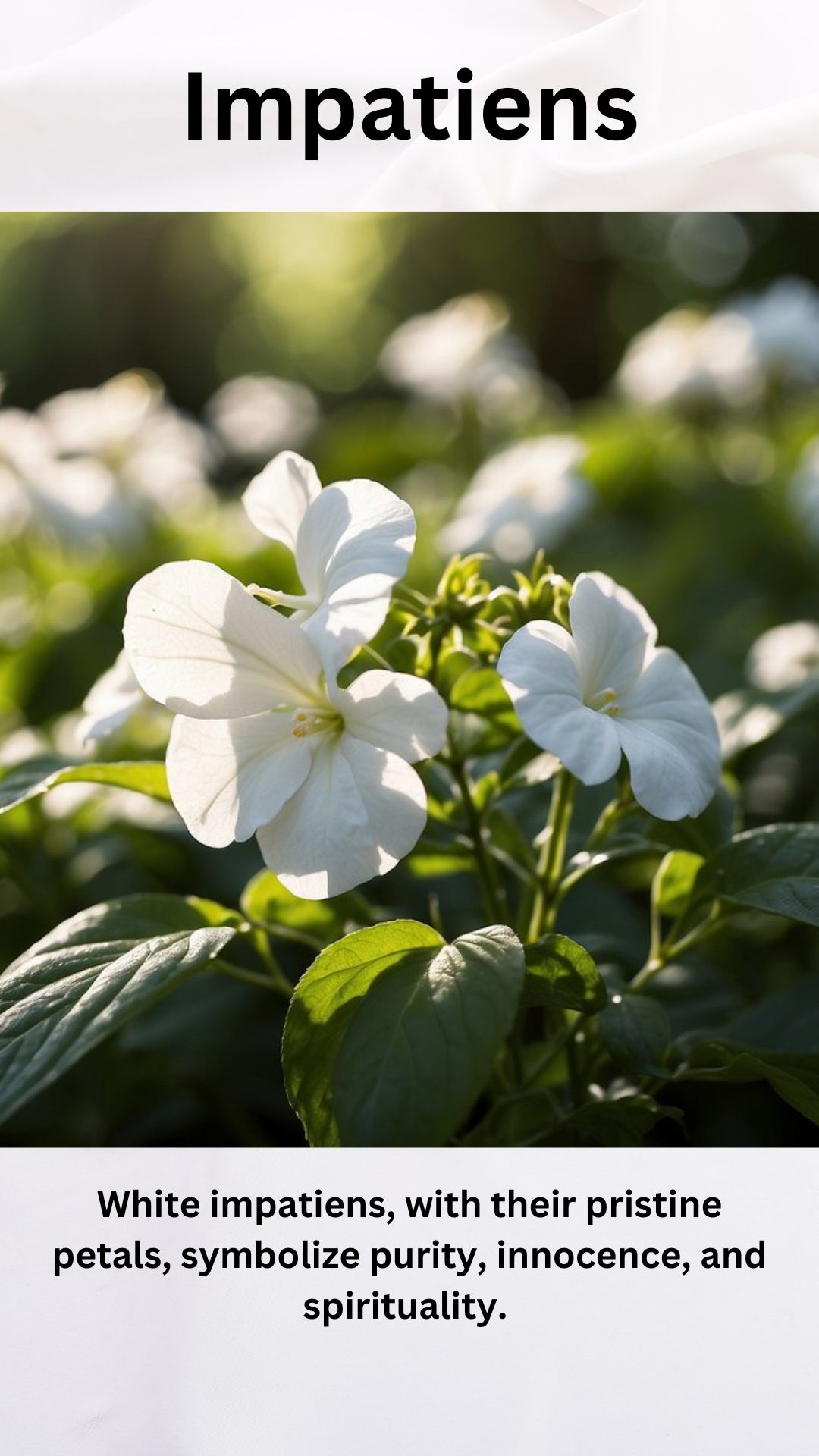
White impatiens, with their pristine petals, symbolize purity, innocence, and spirituality. These charming flowers are perfect for creating a peaceful ambiance. They are often used in moon gardens where they can reflect the moonlight, promoting tranquility.
Due to their gentle appearance, they are ideal for weddings and religious events, infusing the surroundings with a serene aesthetic.
Sun Requirements:
Partial shade to full shade
Bloom Time:
Late spring to the first frosts
Soil Requirements:
Consistently moist, well-drained soil
USDA Zone:
Zones 5 – 11
White impatiens are versatile and thrive in environments that mimic their natural tropical habitat. They desire shade from the harsh sun, making them excellent candidates for shaded garden spots and north-facing windows.
Their extended blooming season ensures a consistent display of snowy flowers. These stand out beautifully against their lush green foliage.
When it comes to soil, they prefer it to be reliably moist without becoming waterlogged. This makes them a delightful companion to ponds or shaded garden paths where the ground retains some dampness.
Gardeners love incorporating them in border plantings or as a part of container gardens, where they add elegance and a fine texture.
Given their hardy nature, these impatiens can prosper in a range of climates. This makes them a popular choice across many USDA hardiness zones. Their adaptability and stunning white blossoms make them a joyful addition to any garden setting.
White Begonia
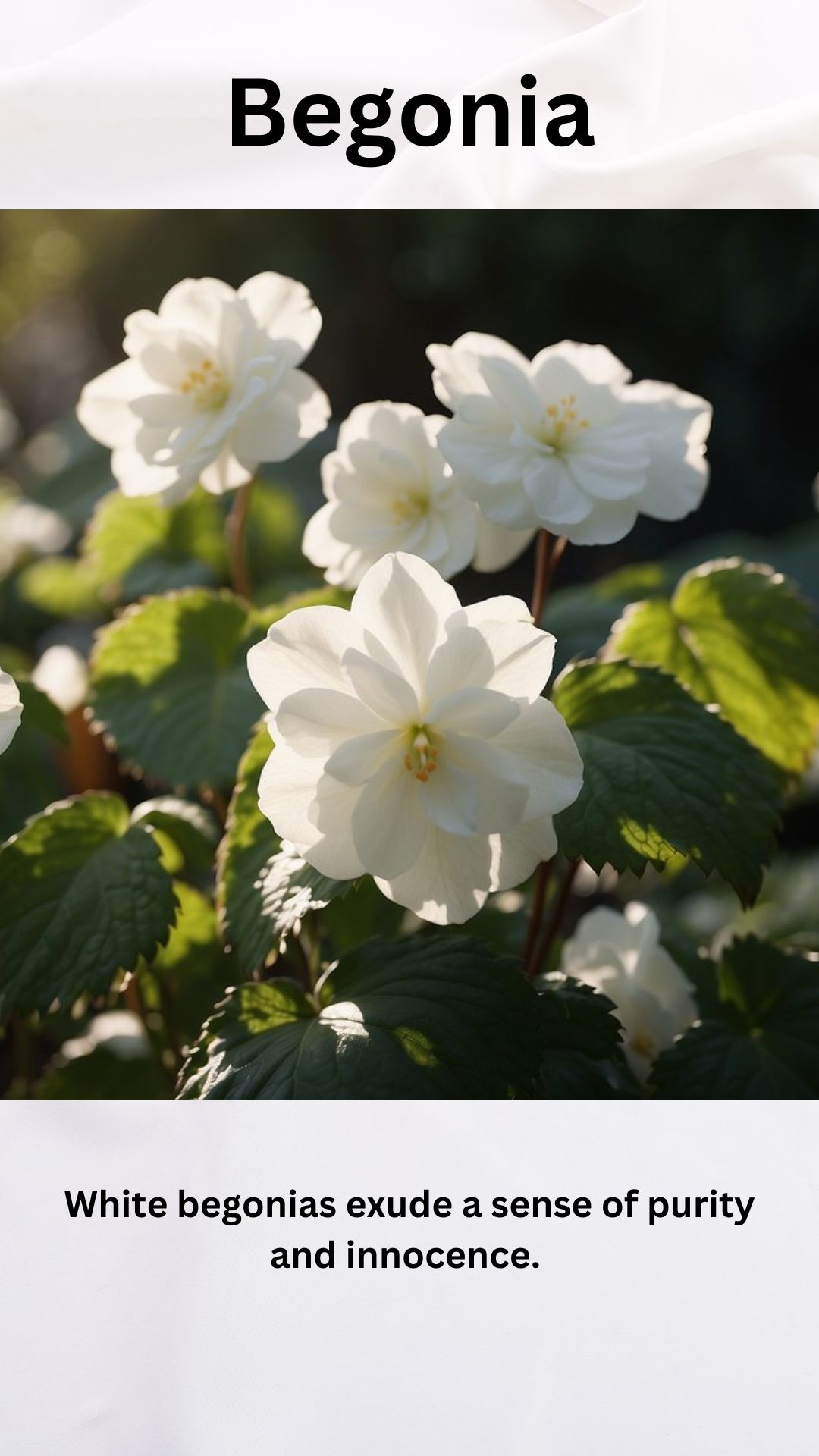
Meaning and Use Cases:
White begonias exude a sense of purity and innocence. They are imbued with symbolism, often associated with a message of harmony and spiritual connection.
Gardeners and decorators use them extensively to create a serene and elegant ambiance in gardens, homes, and various events.
Sun Requirements:
White begonias thrive in a setting that offers filtered sunlight, as direct exposure can harm their delicate petals.
They enjoy bright, indirect light which fosters their lush growth.
Bloom Time:
The bloom period for white begonias typically spans the warmer months.
They start to showcase their vibrant blossoms in late spring and can continue to delight the eye until fall, providing an extended season of beauty.
Soil Requirements:
To flourish, white begonias prefer well-drained soil that remains moist but not waterlogged.
They demand a balanced environment where nutrients are plentiful and drainage is optimal.
USDA Zone:
These flowers are suited for USDA zones 6 to 9, where they can be nurtured as perennials.
In cooler climates, they can be treated as annuals or moved indoors to overwinter.
Table: White Begonia At-a-Glance
| Attribute | Details |
|---|---|
| Sunlight | Bright, indirect light |
| Bloom Time | Late spring to fall |
| Soil | Moist, well-drained |
| USDA Zone | 6-9 |
White Cosmos
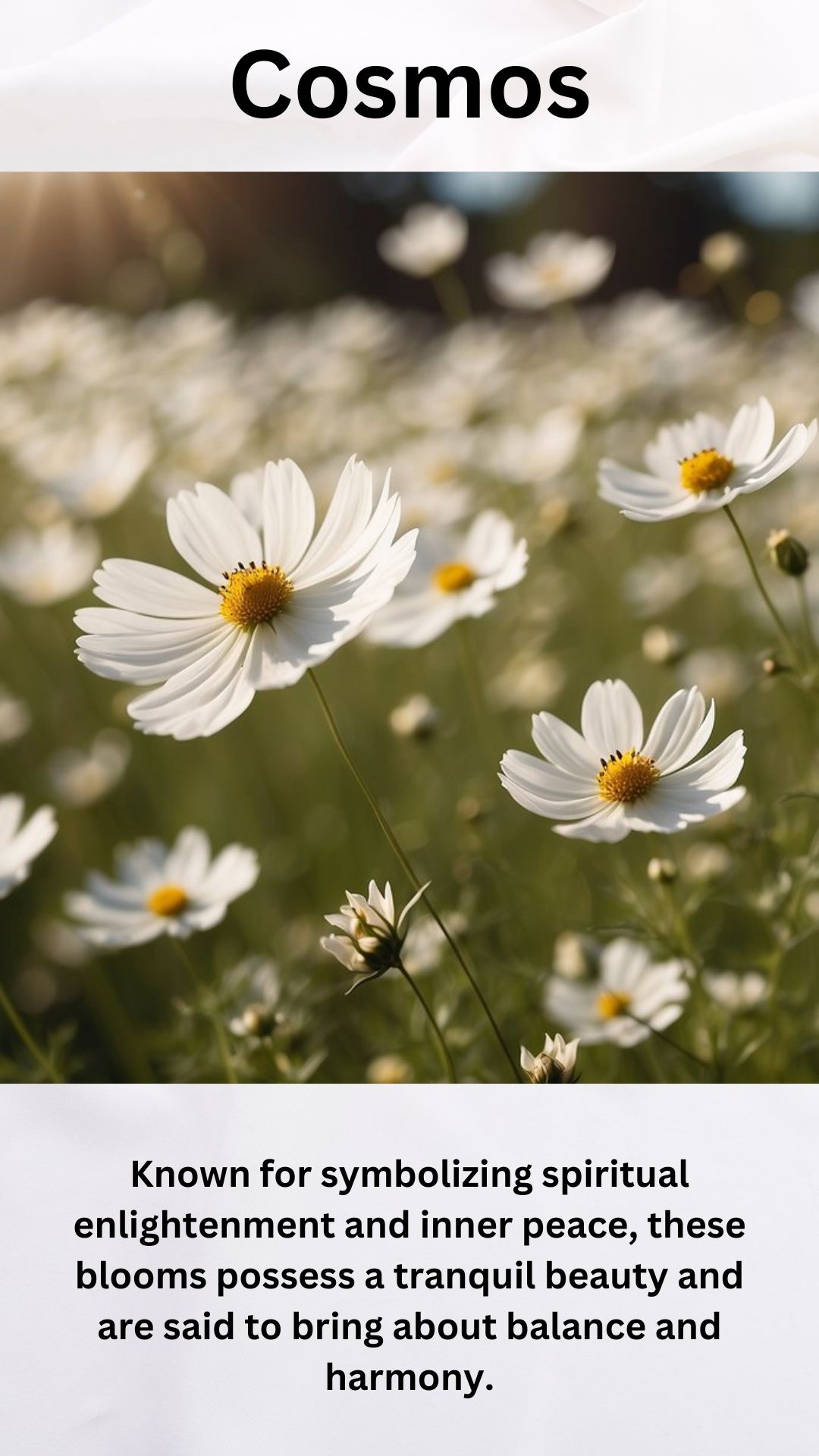
White cosmos flowers offer a pure and uplifting presence in any garden. Known for symbolizing spiritual enlightenment and inner peace, these blooms possess a tranquil beauty and are said to bring about balance and harmony.
They are often utilized in gardens designed for reflection or meditation and are a popular choice for weddings due to their representation of purity and love.
White cosmos are sun-loving annuals that thrive under full sunlight conditions, requiring at least 6-8 hours of direct sunlight daily to bloom successfully.
Gardeners cherish these flowers for their lengthy bloom time, which lasts from midsummer until the first fall frost, offering a prolonged display of their ethereal beauty.
Soil requirements for white cosmos are undemanding; they prefer well-draining soil and can tolerate nutrient-poor, sandy soils.
This resilience makes them a favorite among both novice and experienced gardeners.
When planting white cosmos, consider your local climate, as these flowers are suitable for a wide range of USDA zones, typically from zone 2 to 11.
It is important to provide ample space for growth, as they can reach 2 to 4 feet in height.
To ensure the health of cosmos flowers, remember to:
- Water them regularly, but avoid over-watering.
- Fertilize sparingly, as too much can reduce their blooms.
- Deadhead spent flowers to encourage further blooming.
White Phlox

White Phlox, with its clusters of pristine white blooms, exudes a charm that’s hard to overlook in any garden. These flowers are renowned not just for their aesthetic appeal but for their symbolism too.
They represent purity and new beginnings, making them a perfect choice for weddings and celebratory occasions.
In terms of use cases, white phlox brings an undeniable allure to flower arrangements and garden beds.
Due to its harmonious vibe, it’s often chosen to foster a sense of unity at events.
Here’s what garden enthusiasts need to know to grow White Phlox successfully:
- Sun Requirements: These flowers thrive in full sun but can tolerate partial shade.
- Bloom Time: Expect white phlox to grace your garden with its presence in summer through to the early fall.
- Soil Requirements: The ideal soil for white phlox is well-drained, with a preference for a slightly alkaline to neutral pH.
- USDA Zone: White phlox does best in USDA Zones 4 to 8.
One standout variety mentioned in the search results is Phlox paniculata Flame White Eye.
It grows to about 18 inches tall and is especially loved for its fragrant blooms that attract butterflies and birds, making the garden a lively, fluttering place.
White Morning Glory
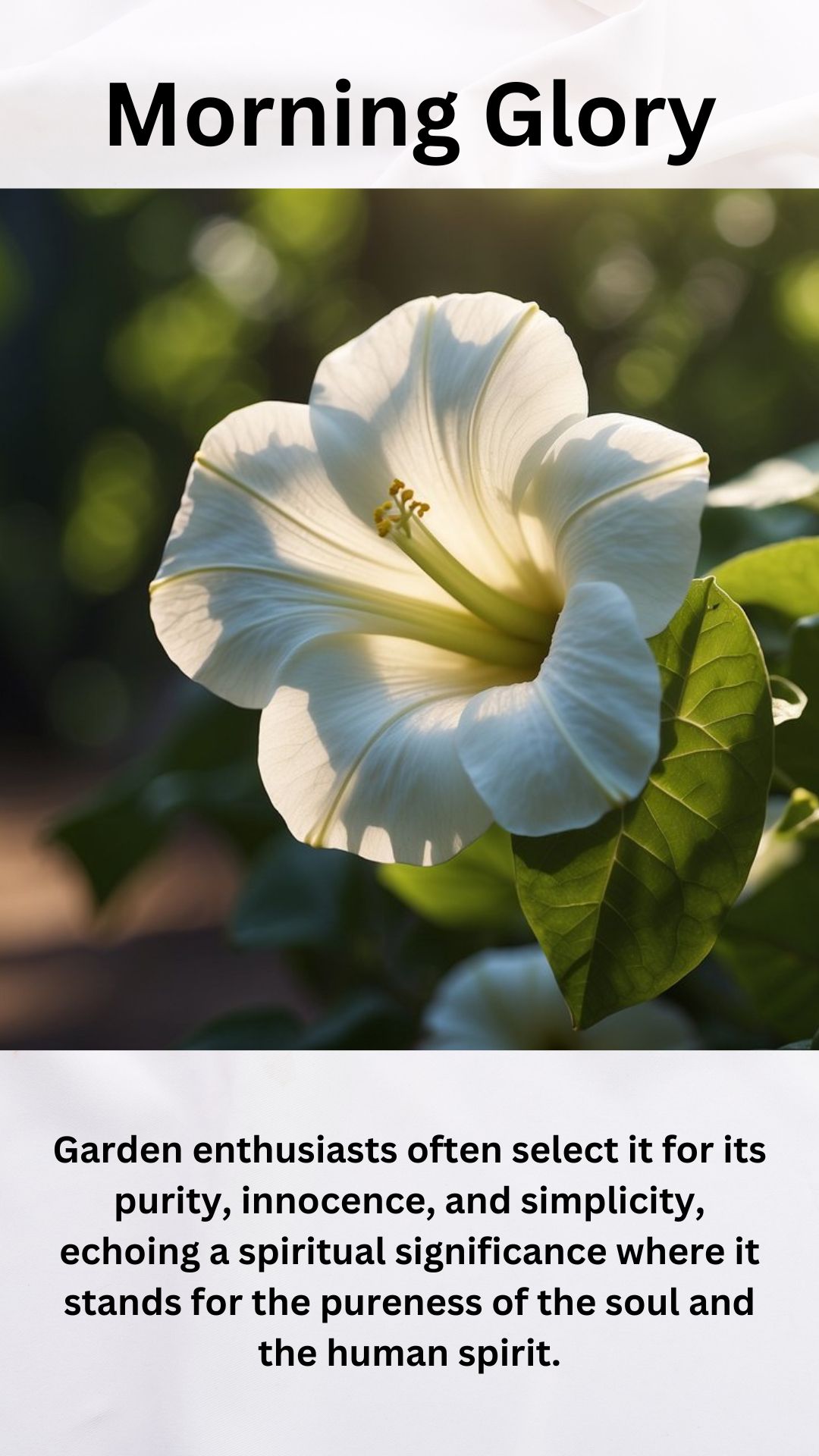
The White Morning Glory flower is a captivating bloom, steeped in symbolism and beauty.
Garden enthusiasts often select it for its purity, innocence, and simplicity, echoing a spiritual significance where it stands for the pureness of the soul and the human spirit.
Not only is the White Morning Glory stunning in aesthetics with its divine trumpet-like shape, but it also carries an appealing symbolism of prayer and devotion.
Meaning and Use Cases
In gardens and cultural ceremonies, White Morning Glories are utilized for their heavenly looks and the serenity they impart.
They are perfect for spaces intended to invoke tranquility and mindfulness.
Sun Requirements
Full sun is the White Morning Glory’s best friend. It thrives under direct sunlight, making the most of glorious summer days to bloom.
Bloom Time
The enchanting White Morning Glory is known for greeting gardeners with blooms in the early morning, which tend to close up as the day progresses.
Soil Requirements
For optimal growth, they prefer well-drained soil, able to retain moisture without becoming waterlogged.
USDA Zone
These flowers flourish in USDA zones 3 to 10, showcasing both versatility and resilience across climates.
The White Morning Glory is a testament to nature’s wonders, embodying profound symbolism and presenting an appealing choice for flower connoisseurs looking to express purity and awakening in their horticultural pursuits.
The pure color and renewing nature of this bloom offer a daily reminder of new beginnings, as they open each day to greet the sunshine.
White Pansy
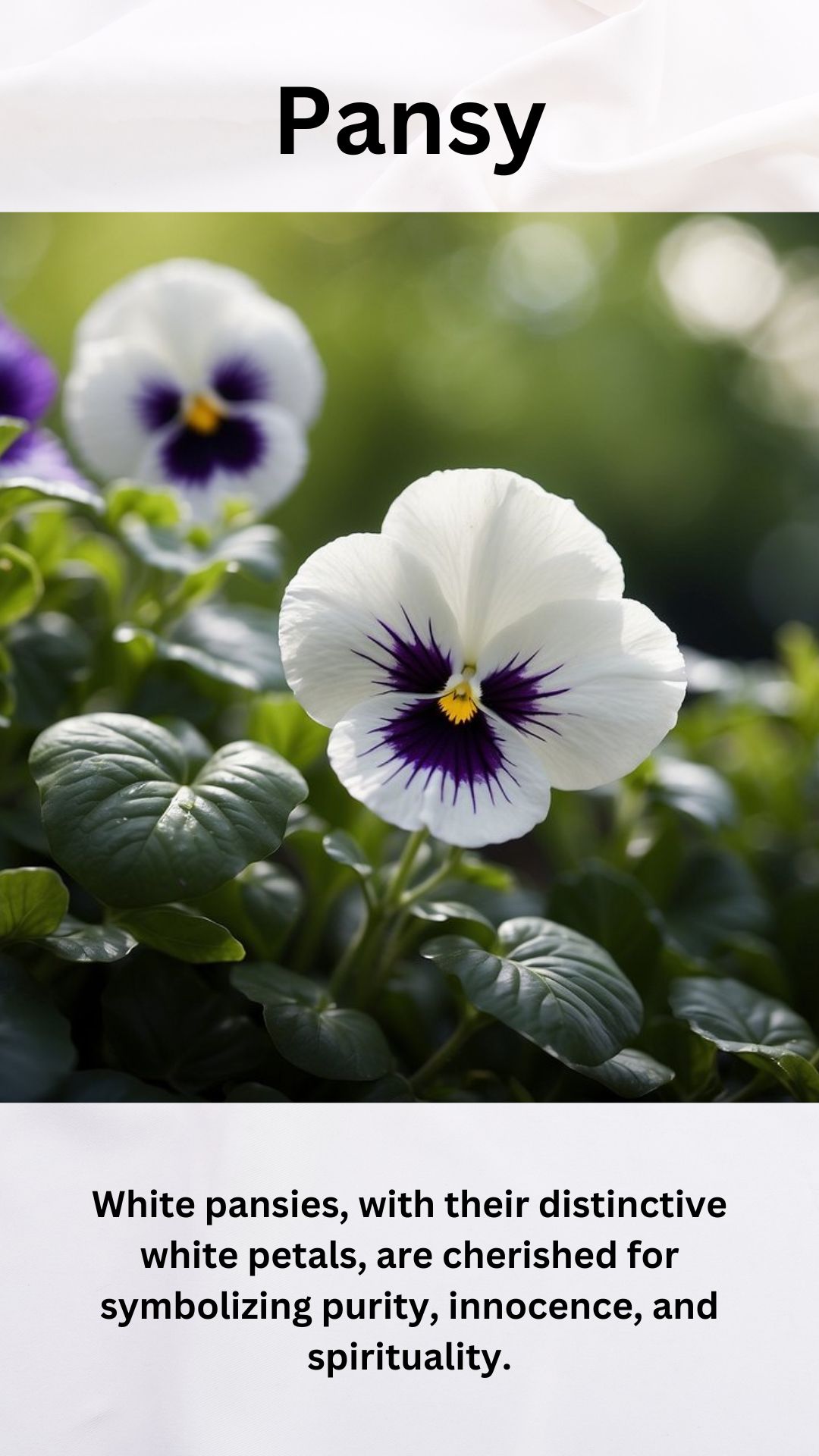
White pansies, with their distinctive white petals, are cherished for symbolizing purity, innocence, and spirituality.
These blossoms often grace gardens and bouquets, contributing a serene touch to the floral composition.
Gardeners adore white pansies not just for their charm but also for the meaning they convey; they’re frequently used to express thoughtfulness and remembrance, making them an ideal gift for someone special.
Meaning and Use Cases
White pansies are versatile in their use.
They are perfect for wedding bouquets and ceremonial arrangements, where they represent the pure love between individuals.
In gardens, they provide a peaceful nook of tranquility, often used to enhance meditative spaces.
Growing Conditions
- Sun Requirements: White pansies thrive in full to partial sun. They require plenty of light to bloom but also appreciate some shade during the hottest part of the day.
- Bloom Time: These flowers are known for their early spring to late fall blooming seasons, offering a long period of enjoyment.
- Soil Requirements: They prefer well-drained soil that is rich in organic matter. The ideal pH for pansy soil is slightly acidic to neutral.
- USDA Zone: White pansies perform best in USDA zones 6 to 10, handling a variety of climates with grace.
Plant enthusiasts celebrate white pansies not just for their aesthetic appeal but also for their adaptability.
They are relatively easy to care for and can bring beauty and symbolism to gardens and homes alike.
Whether planted in containers, beds, or borders, white pansies fill the air with excitement and a hint of nature’s wonder.
White Stock
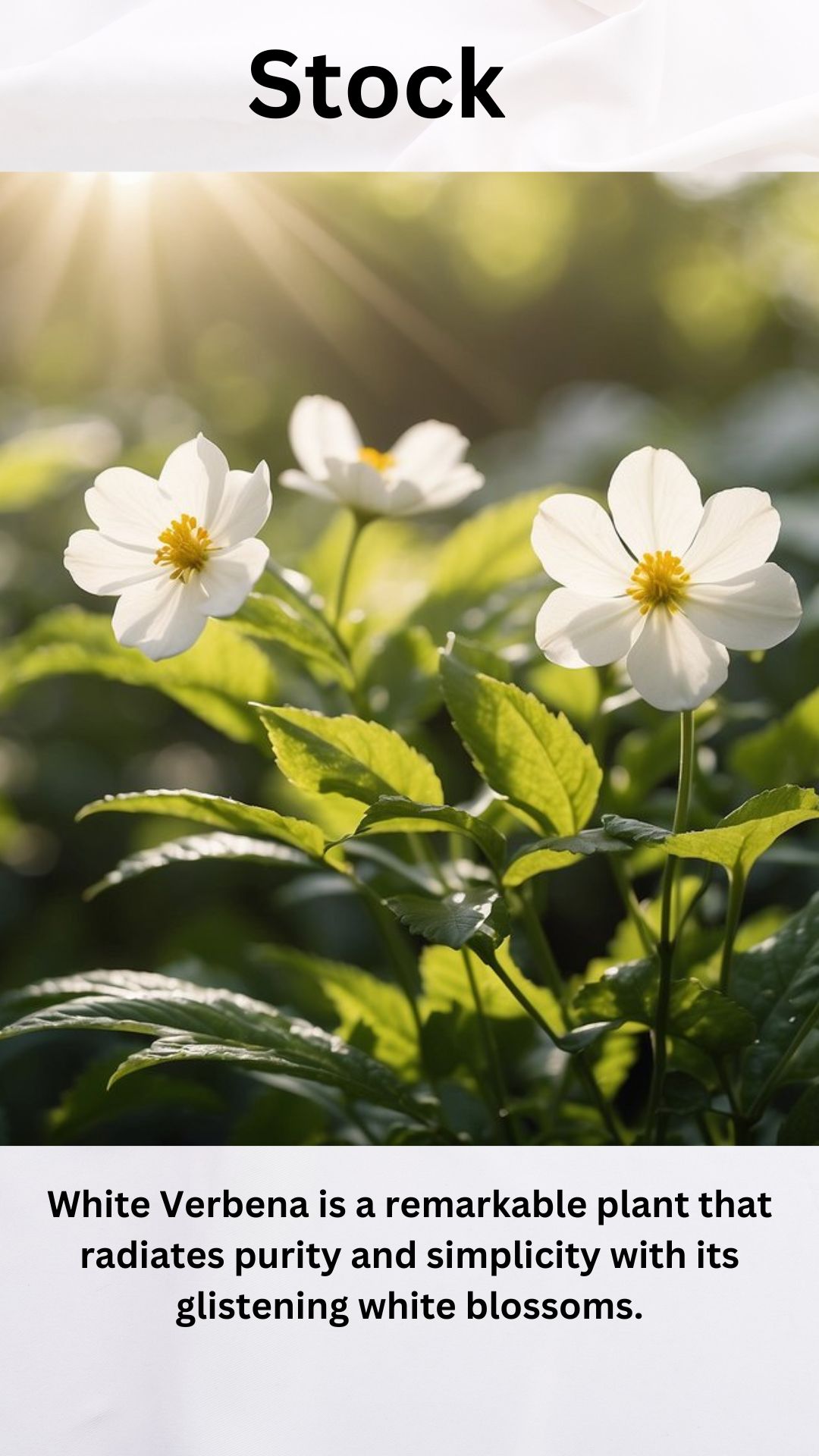
White Stock flowers, known scientifically as Matthiola Incana, are enchanting blooms that resonate with deep meaning.
Meaning and Uses: White Stock is treasured for its representation of purity and innocence. Its usage spans across various events, adding elegance to weddings and offering consolation at funerals.
The flower’s delightful fragrance and pristine color also make it a symbol of both spirituality and serenity, perfect for enhancing the ambiance in any setting.
Sun Requirements: These blooms relish the full sun but appreciate a bit of afternoon shade in hotter climates to maintain their vibrant splendor.
Bloom Time: Phase of Splendor: White Stock typically unveils its beauty in the late spring to early summer, gracing gardens with its presence.
Soil Requirements: The ideal soil for White Stock is well-drained, rich in organic matter, and with a neutral to slightly alkaline pH level. Consistency in moisture without waterlogging is key to their growth.
USDA Zone: They fare well in USDA zones 7 to 10, thriving in milder climates.
Cultivating White Stock allows gardeners and flower enthusiasts to bring a touch of timeless romance and heartfelt symbolism to their landscapes and arrangements.
With its simple yet profound meanings, White Stock continues to captivate hearts around the globe.
White Verbena

White Verbena is a remarkable plant that radiates purity and simplicity with its glistening white blossoms.
These flowers carry a symbolism of peace and innocence, making them an excellent choice for various floral arrangements, particularly in celebrations signifying new beginnings, such as weddings.
Gardeners appreciate the versatility of White Verbena, as it thrives under full sun, generously offering its delicate clusters from early summer to the first frost.
This endurance makes it a beloved addition to summer gardens.
Planting White Verbena is a delight, as it is adaptable to well-draining soil, though it flourishes most in soil that is mildly acidic to neutral.
Watering should be consistent, ensuring that its thirst is quenched without leaving it drenched.
- Meaning: Peace, innocence
- Use Cases: Weddings, floral gifts, garden beds
- Sun Requirements: Full sun
- Bloom Time: Early summer to first frost
- Soil Requirements: Well-draining, mildly acidic to neutral pH
- USDA Zone: 9-11
As they bask in the sun, gardeners delight in the cascading effect of White Verbena, its generous blossoms spilling over containers and borders, creating a soft, serene statement in any setting.
White Sweet Pea

The White Sweet Pea is a delightful bloom that carries profound symbolism and is cherished for its purity, innocence, and simple elegance. Often found gracing the pages of literature and the strokes of artworks, this flower’s pristine white petals are deeply associated with farewells, goodbyes, and sincere apologies.
It’s no wonder that the White Sweet Pea is a popular choice for events like weddings, embodying the purity of love and the optimistic anticipation of new beginnings.
Meaning and Use Cases:
- Purity: The white petals represent cleanliness and innocence.
- Beginnings: Ideal for ceremonies signifying fresh starts.
- Apologies: Conveys remorse in a sensitive manner.
Cultivation Details:
| Requirement | Specification |
|---|---|
| Sun Requirement | Prefers full sun to partial shade |
| Bloom Time | Flourishes in the cool seasons |
| Soil Requirement | Favors well-drained, rich soil |
| USDA Zone | Thrives in zones 2 through 11 |
Gardeners and florists are excited about the White Sweet Pea for its flexibility and grace. It flourishes in a variety of conditions, eagerly reaching for the sun, yet it tolerates partial shade with resilience.
Most vibrant in cooler seasons, it brings joy to the garden when many other flowers are not yet in bloom. With its sweet fragrance, it’s no surprise that the White Sweet Pea is also a darling of the perfumery world.
This enchanting flower commences its show in the earliest whispers of spring, inviting gardeners to celebrate the season’s arrival.
When planting, one must ensure the soil is fertile and well-drained to allow these beauties to reach their full potential.
A wide range of enthusiasts can grow White Sweet Peas, as they are hardy across an impressive span of USDA zones.
White Bleeding Heart
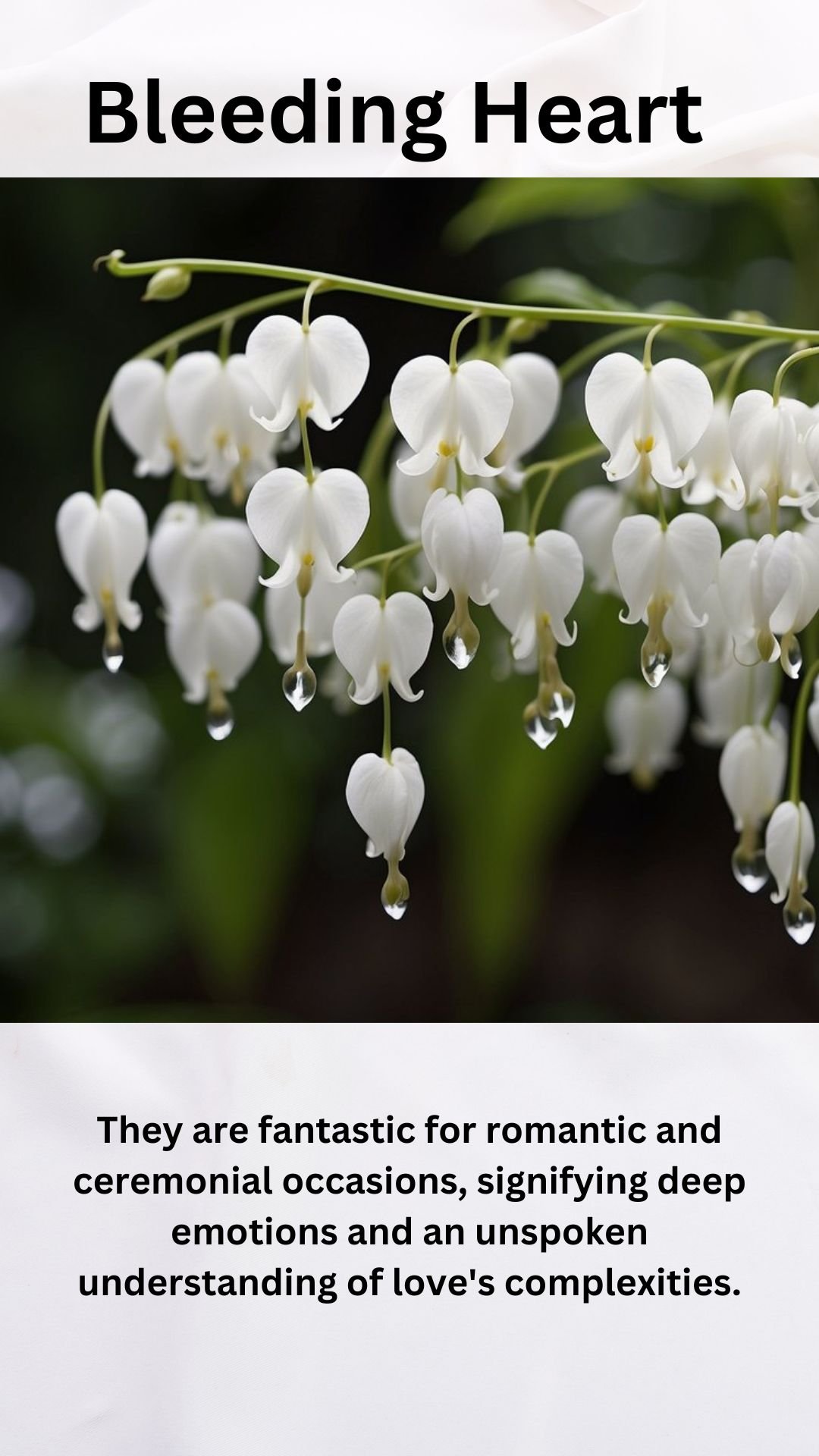
Dicentra spectabilis ‘Alba’, commonly known as the White Bleeding Heart, is a captivating addition to any garden with its heart-shaped flowers and graceful arching stems.
Often imbued with profound symbolism, it usually represents purity and innocence due to its white hue, depicting love, compassion, and other strong emotional bearings.
Meaning and Use Cases:
White Bleeding Heart flowers are treasured not only for their unique beauty but also for their symbolism.
They are fantastic for romantic and ceremonial occasions, signifying deep emotions and an unspoken understanding of love’s complexities.
Sun Requirements:
- Partial shade to full shade
Bloom Time:
- Late spring to early summer
Soil Requirements:
- Moist, well-drained soil
- Neutral to slightly acidic pH is preferred
USDA Zone:
- Zones 3 through 9
Gardeners adore the White Bleeding Heart for its low maintenance and stunning floral display, which light up shadier corners of the garden.
This charming plant requires little direct sunlight, thriving best under a canopy of trees or in a slightly shaded garden area.
With blooms appearing from late spring, it offers a backdrop of elegance and serenity during these lively seasons.
To keep this heartwarming plant content, ensure the soil stays moist and well-nourished with organic matter.
Lastly, spanning across a broad range of USDA zones, it proves to be hardy and adaptable, thriving in many gardens, each stem telling its own tale of purity and enchantment.
White Columbine
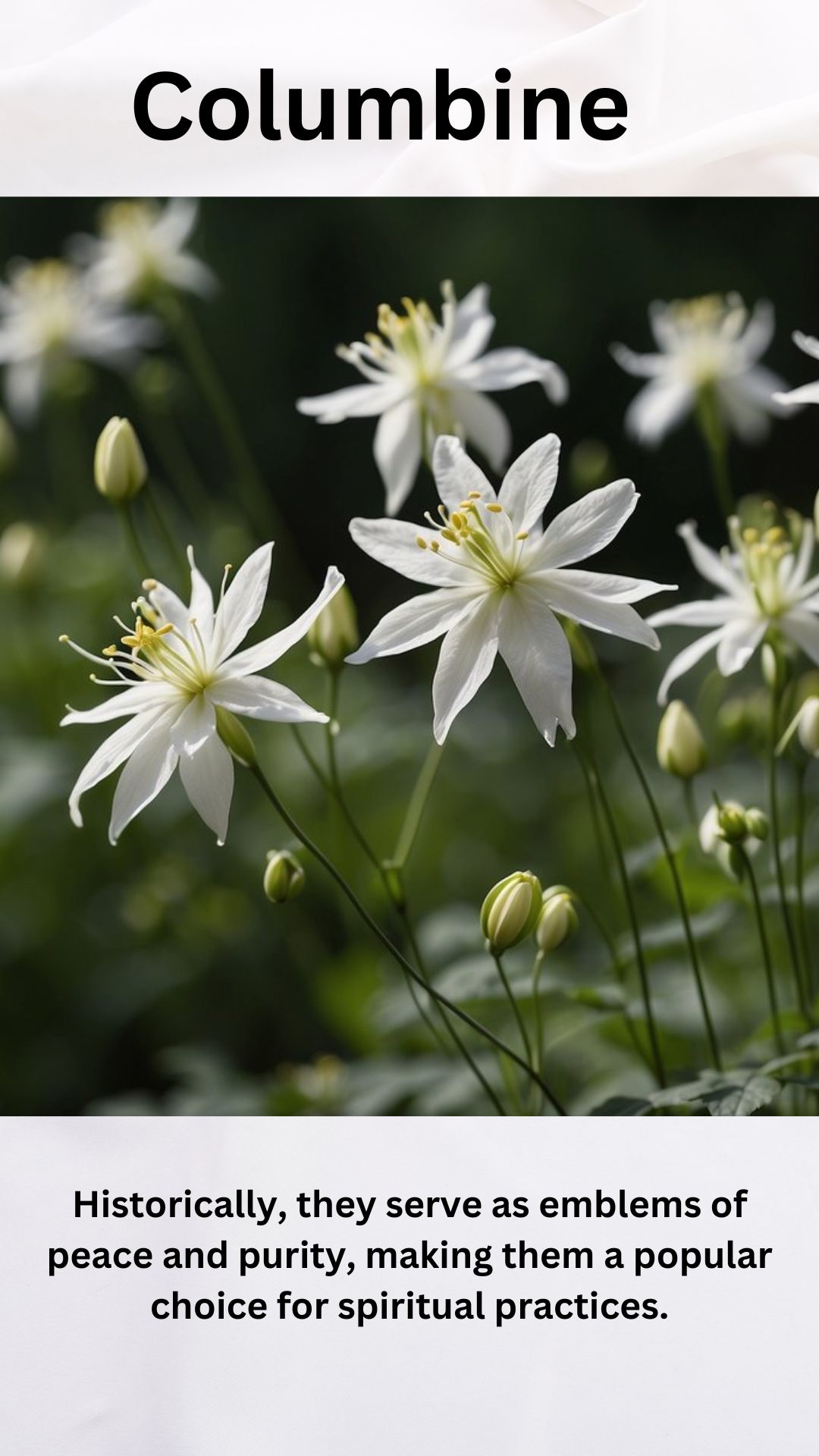
White Columbine flowers (Aquilegia caerulea) are a sight to behold! They signify not only purity and innocence but also have a spiritual aspect, often associated with the Seven Gifts of the Holy Spirit. Historically, they serve as emblems of peace and purity, making them a popular choice for spiritual practices.
Meanings and Uses:
- Purity
- Innocence
- Spiritual significance: Seven Gifts of the Holy Spirit
- Use cases: Spiritual ceremonies, gardening for aesthetic purposes
Growing Preferences:
- Sun Requirements: Partial shade; these flowers thrive under dappled sunlight.
- Bloom Time: Typically in late spring to early summer, adding a pristine splash of white to gardens.
- Soil Requirements: Fertile, well-drained soil; although they can tolerate moderate conditions, they prefer moist, loamy earth.
- USDA Zone: White Columbine does well in zones 3 through 8, showing a wide range of hardiness.
Care Tips:
- Water regularly to maintain moist soil conditions
- Mulching can help retain moisture and keep roots cool
- Deadheading encourages additional blooming
Gardeners everywhere are captivated by the White Columbine’s delicate bell-shaped flowers with their distinctive ‘spur’ at the back. Their charming nodding heads bring an air of elegance to shady garden corners.
As if painted by nature’s own hand, each petal looks as though it’s been carefully dipped in purest white. When the gentle sway of a breeze catches their petals, they dance like celestial lanterns in a secret garden—an enchanting sight, indeed!
White Crocus
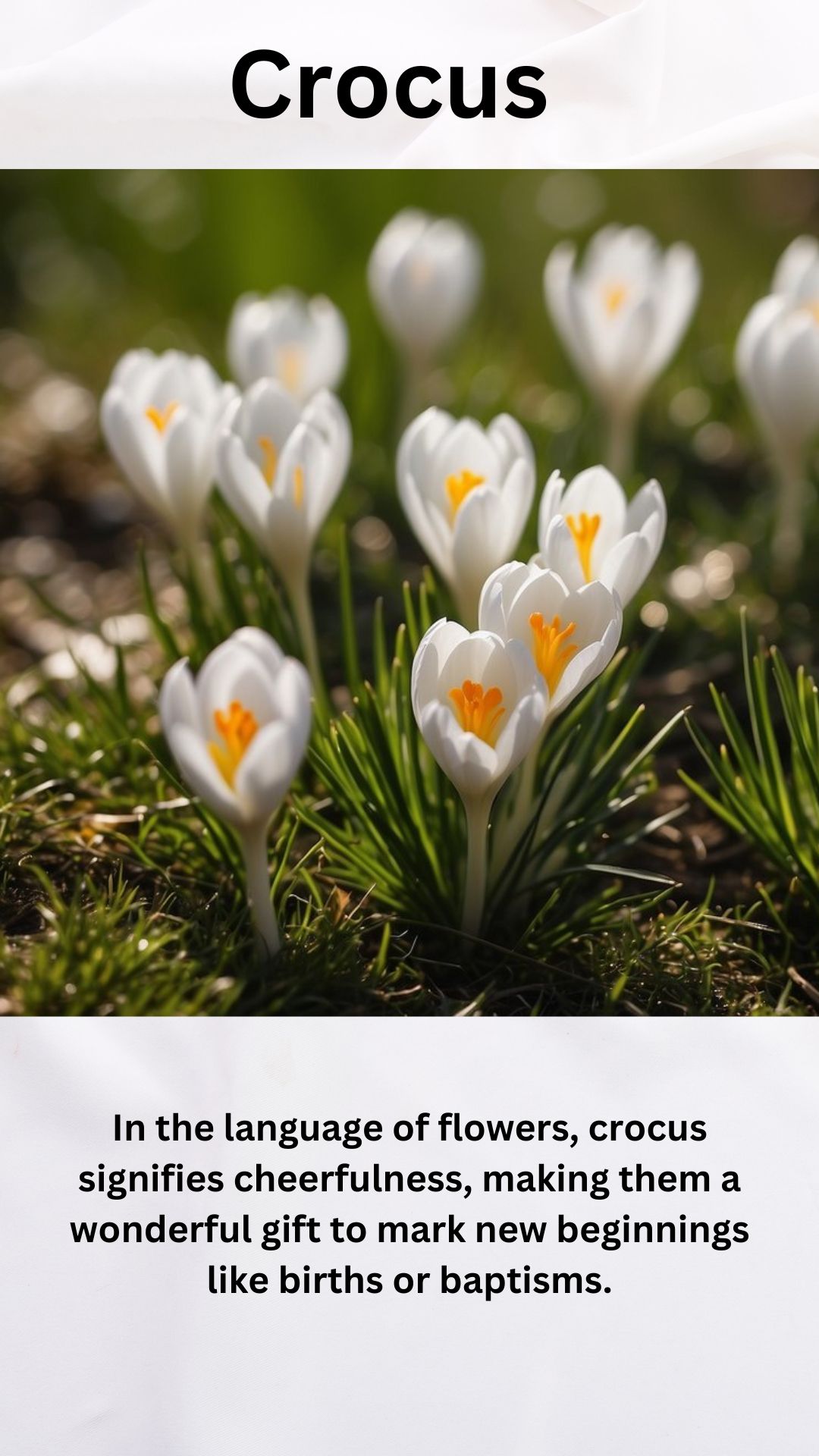
The White Crocus emerges as a herald of spring’s arrival, evoking a sense of pure joy and renewal. These delicate blooms are highly esteemed for their pristine beauty and are often linked with purity and innocence. In the language of flowers, crocus signifies cheerfulness, making them a wonderful gift to mark new beginnings like births or baptisms.
Sun Requirements:
- White Crocuses thrive under full sun to partial shade. They relish the early spring sunlight, yet appreciate a little afternoon shade in hotter regions.
Bloom Time:
- Celebrated for being one of the first to bloom as winter wanes, their flowers grace gardens from late winter to early spring.
Soil Requirements:
- These flowers prefer well-drained soil, which prevents bulbs from rotting. A neutral to slightly acidic pH suits them best.
USDA Zone:
- White Crocuses are hardy in USDA zones 3 through 8, showcasing their adaptability to a range of cool to temperate climates.
The presence of crocin offers anti-inflammatory and antioxidant benefits. Historically, they’ve been employed to alleviate various ailments, which underscores their significance beyond mere aesthetics.
White Freesia
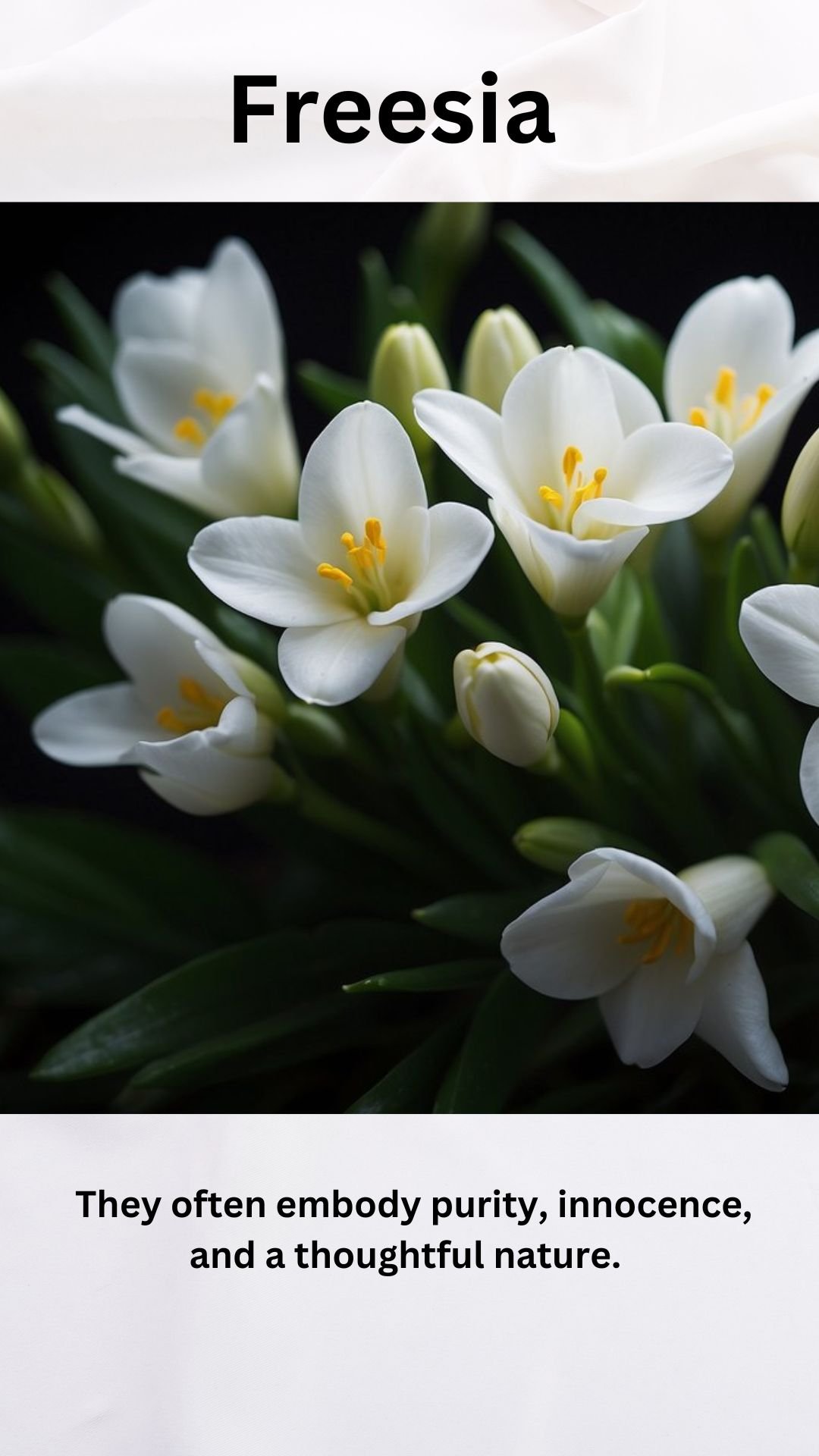
White freesias are delightful flowers, celebrated not only for their striking appearance but their rich symbolism and enchanting fragrance. They often embody purity, innocence, and a thoughtful nature. Gifts of white freesias can symbolize respect and trust, making them superb choices for weddings, where they bring an air of grace and elegance to floral arrangements.
These blossoms thrive in conditions that provide full sun to partial shade, making them versatile for gardeners. They herald the arrival of spring, with a bloom time that delights from late winter to early spring. White freesias prefer well-draining soil, ensuring they remain moist without becoming waterlogged.
For those eager to cultivate these flowers in a home garden, they perform best in USDA zones 9 through 11. Gardeners in these zones can revel in the sight of white freesias enlivening their gardens.
Here’s a brief summary of white freesia’s requirements:
| Requirement | Detail |
|---|---|
| Sun | Full sun to partial shade |
| Bloom Time | Late winter to early spring |
| Soil | Well-draining |
| USDA Zone | 9 to 11 |
Their meaningful beauty and straightforward care make white freesias a cherished flower among enthusiasts and professionals alike. They’re not only a joy to behold but also carry a sense of serenity that can brighten one’s day and garden with ease.
White Gladiolus

The white gladiolus flower is a captivating symbol of purity and elegance. It’s cherished for its tall, magnificent blossoms that command attention in any setting. These striking flowers are often incorporated in celebratory events like weddings, signifying new beginnings and heartfelt commitments.
Meaning and Uses:
- Purity: White gladiolus represents cleanliness and fresh starts.
- Elegance: Their grace makes them perfect for sophisticated occasions.
- Symbolism: They embody strength of character, moral integrity, and sincerity.
Sun Requirements:
- Light: Prefers full sun exposure to flourish and shine.
Bloom Time:
- Season: Graces gardens with its presence in the summer months.
Soil Requirements:
- Type: Well-drained soil is crucial for healthy growth.
- pH: Slightly acidic to neutral soil pH is optimal.
USDA Zone:
- Range: Thrives in USDA zones 8 through 11.
In their natural habitat, white gladiolus stands tall and robust, much like a gladiator of the plant world, showcasing their blooms during the warm, vibrant days of summer. They seek the embrace of the sun’s full strength to unveil their large, ruffled petals.
Gardeners often plant the white gladiolus for its magnificent display and impactful symbolism. This flower makes a statement with about 12 showy blooms per stem and can reach a height of 3 to 4 feet. Caretakers should plant them in well-draining soil to ensure their spectacular showcase. With proper care, these flowers express a joyful exuberance that is truly contagious!
White Ranunculus
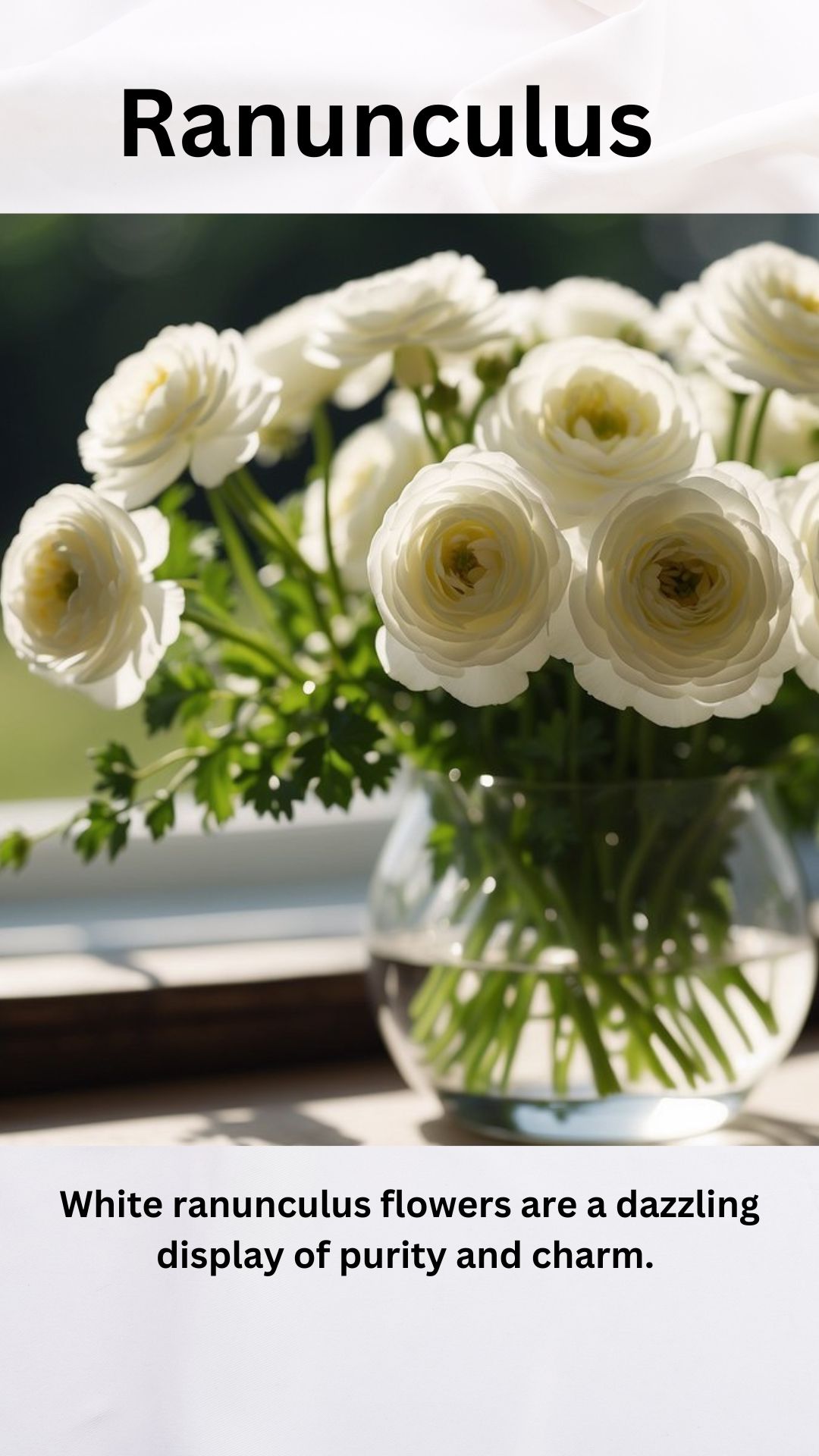
White ranunculus flowers are a dazzling display of purity and charm. These flowers carry deep symbolic meanings of innocence and beauty, making them a perfect choice for weddings and formal events. The sight of their delicate, layered petals often reminds individuals of a fresh start or new beginnings, an excellent motif for nuptial celebrations.
Sun Requirements
- White ranunculus thrive under full sun exposure, contributing to their brilliant vibrancy. However, they do appreciate some shade in the afternoon, especially in hotter climates to protect their elegant blooms.
Bloom Time
- White ranunculus enthusiasts eagerly await their bloom time which occurs in spring, a season synonymous with rebirth and renewal.
Soil Requirements
- The soil requirements for white ranunculus include well-draining soil, as they dread having wet feet. Rich, loamy soil gently boosts their growth, ensuring the soil stays moist but not oversaturated.
USDA Zone
- The optimal USDA zones for cultivating white ranunculus range from zones 3-7. This relatively wide range enables many gardeners to enjoy the presence of these magnificent blooms.
Gardeners and florists alike get excited about the white ranunculus for their aesthetic appeal as well as their profound significances in floristry. They indeed make a breathtaking addition to any garden or bouquet, imparting an essence of youthful beauty and pure elegance wherever they appear.
White Scabiosa
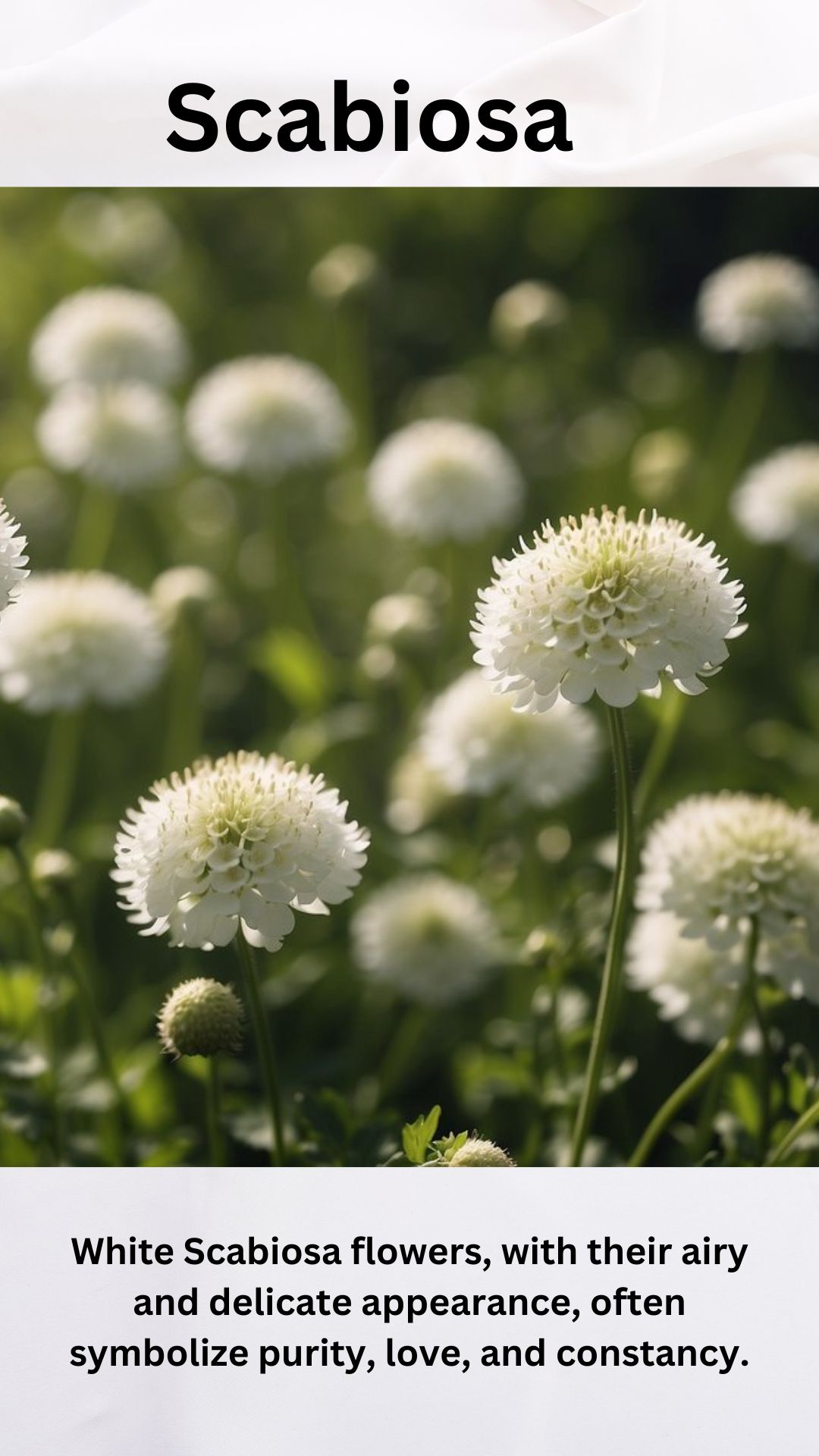
Meaning and Uses
White Scabiosa flowers, with their airy and delicate appearance, often symbolize purity, love, and constancy. In historical art, they are depicted as emblems of the Virgin Mary’s purity. They have also been known to represent sorrow and mourning, thus finding a place in various cultural ceremonies.
Sun Requirements
- These charming blooms relish in full sun to partial shade. They deserve a spotlight in the garden where they can soak up those golden rays, ensuring the abundance of their delightful flowers.
Bloom Time
- The White Scabiosa proudly presents its blooms from late spring to fall, gracing gardens with an extended floral show that is truly a sight to behold.
Soil Requirements
- They thrive in well-drained soil, showing a penchant for moderate conditions, not too dry or overly moist, making them quite adaptable.
USDA Zone
- White Scabiosa flowers are suited for USDA hardiness zones 3 through 9, proving their resilience and versatility across various climates.
Plant Profile Table
| Feature | Detail |
|---|---|
| Sunlight | Full sun to partial shade |
| Bloom Time | Late spring to fall |
| Soil Requirements | Well-drained |
| USDA Hardiness Zones | 3 – 9 |
White Lantana
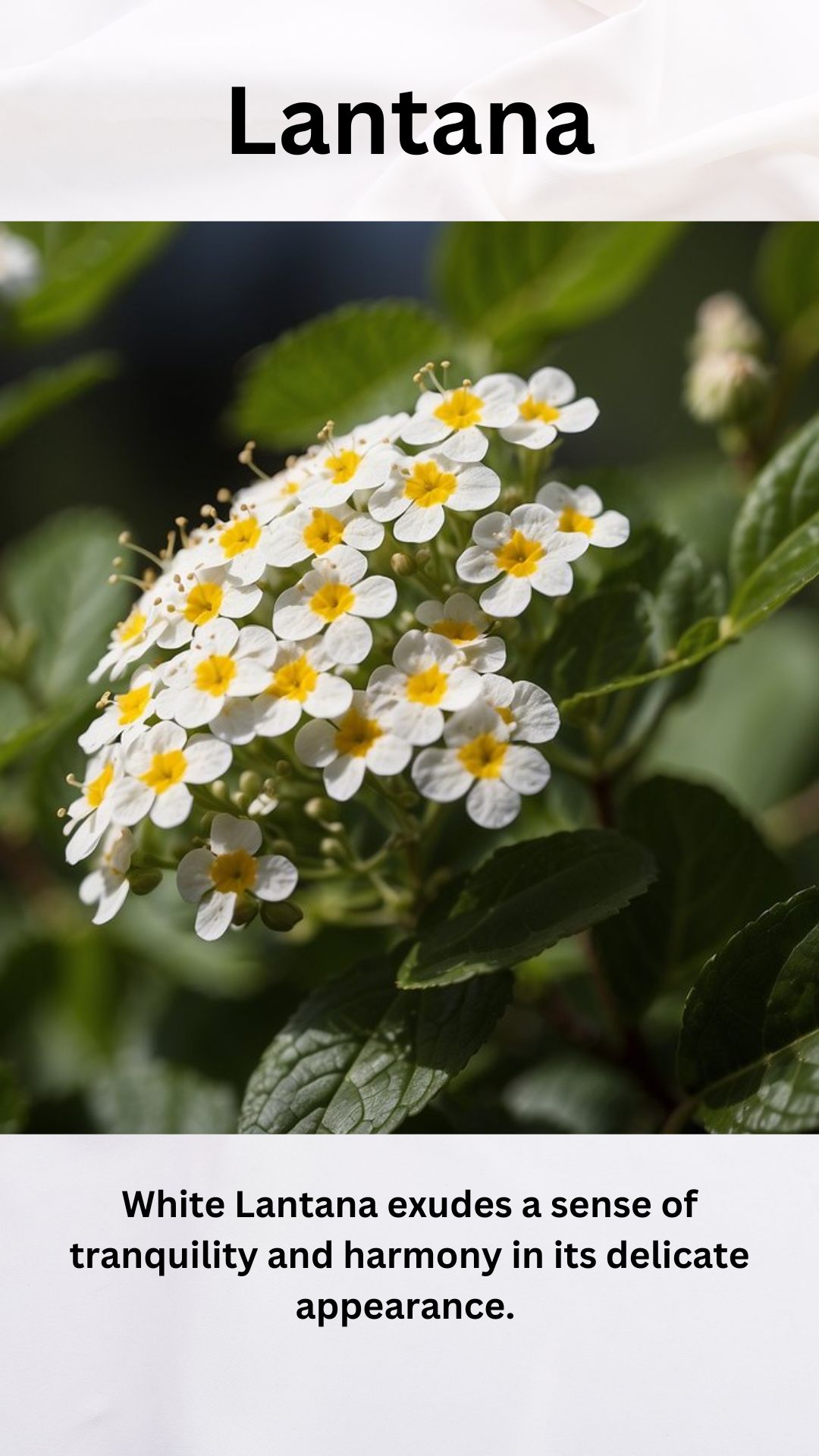
White Lantana exudes a sense of tranquility and harmony in its delicate appearance. It’s a choice plant for those looking to inject a dose of peace into their gardens.
Often tied to purity and positive energy, it’s a symbol of good luck and can lift the spirits of any space.
Sun Requirements: This sun-loving shrub thrives under full sun exposure. It’s essential for the plant’s growth and the vibrancy of its blooms.
Bloom Time: White Lantana graces gardens with its beautiful flower clusters from late spring all the way through to fall. This provides an extended display of its charming blossoms.
Soil Requirements: It prefers well-drained soil, which helps to keep its roots healthy and prevent waterlogging.
USDA Zone: It flourishes in USDA Hardiness Zones 9-11, making it suitable for warmer climates where frosts are a rare occurrence.
| Feature | Details |
|---|---|
| Symbolism | Tranquility, Harmony, Good Luck |
| Sun Exposure | Full Sun |
| Bloom Period | Late Spring to Fall |
| Soil Preference | Well-drained |
| USDA Hardiness | Zones 9-11 |
Gardeners enjoy White Lantana not only for its aesthetic appeal but also for its ability to attract pollinators.
Butterflies and hummingbirds are often seen fluttering around the clusters of white to creamy flowers with yellow centers, fully embracing the life that this plant brings to any garden ensemble.
White Statice

White Statice, scientifically known as Limonium, is a symbol of remembrance and sympathy. Bridging the physical and spiritual, it graces occasions with its purity and tranquility, making it ideal for weddings, providing pure intentions, as well as in sympathy arrangements, signifying heartfelt remembrance.
Meaning and Uses
- Resilience: Often associated with enduring life’s challenges
- Sympathy: Used in arrangements for memorials and solemn occasions
- Purity: Emphasizes clean, unblemished emotions
When it comes to gardens and bouquets, White Statice shines with a year-round blooming capability. This adheres to its symbolism by enduring through all seasons.
Sun Requirements
White Statice flourishes under full sun conditions, basking in its warmth to reveal its full beauty.
Bloom Time
Abundant bloomer throughout summer and can extend into fall, depending on the climate.
Soil Requirements
Prefers well-drained soil, leaning towards the sandy side, with moderate fertility levels.
USDA Zone
Find its best growth in USDA Zones 7-10, showcasing its versatile nature across a range of warmer climates.
Gardeners and floral enthusiasts are often thrilled watching White Statice emerge as it requires relatively minimal care. With its resilience, White Statice stands out as an exceptional choice embodying purity and a steadfast spirit in both gardens and symbolic flower arrangements.
White Yarrow

White Yarrow, with its scientific name, Achillea millefolium, is steeped in ancient folklore and brims with symbolism. Renowned for its healing properties, white yarrow commonly signifies healing, protection, and divination. People historically used it to stanch the flow of blood from wounds, which ties to the legend of the Greek hero Achilles.
In the realm of spirituality, this plant is often connected to the power of providing answers to critical life questions.
Sun Requirements and Bloom Time:
- Sun Requirements: Full sun to thrive
- Bloom Time: Early to late summer, delighting gardeners with vibrant displays.
Soil Requirements and USDA Zone:
- Soil Requirements: Well-drained soil; white yarrow is quite tolerant of drought conditions.
- USDA Zone: Hardy in zones 3-8.
White yarrow is not just another pretty face in the flower bed; it’s a botanical powerhouse!
Those eternally cheerful flat-topped clusters of creamy-white flowers shoot up from fern-like, aromatic foliage that not only adds texture but is also a disease-resistant champion.
Gardeners adore integrating white yarrow in their floral compositions, especially for those sunny spots that other plants might shy away from. It’s a plant that excels at being both ornamental and functional.
White Datura

White Datura captivates with its ethereal trumpet-shaped blooms, embodying a mystical aura in gardens and floral arrangements.
Revered for their striking beauty, these flowers carry a blend of symbolism.
Meaning and Symbolism: Often shrouded in intrigue, the White Datura symbolizes both power and caution.
Its white petals may represent purity and spiritual pursuits, while simultaneously cautioning against its toxic properties.
Uses: Predominantly ornamental, White Datura finds a place in nocturnal gardens due to its ability to bloom in the evening.
Its role in various cultural rituals further amplifies its enigmatic presence.
Sun Requirements: These flowers bask in full sunlight, requiring generous daily exposure to thrive.
Any gardener aiming to grow these stunning blooms should plan for a plot that bathes in the sun’s rays.
Bloom Time: The alluring White Datura blossoms unfold from late spring through early fall, offering a prolonged display of their mesmerizing beauty.
Soil Requirements: It prefers well-draining soil with a neutral to slightly alkaline pH, ensuring optimal health and growth.
USDA Zone: White Datura flourishes in a range of climates, ideally situated within USDA zones 5 through 9.
In these zones, gardeners eagerly anticipate their return each year.
